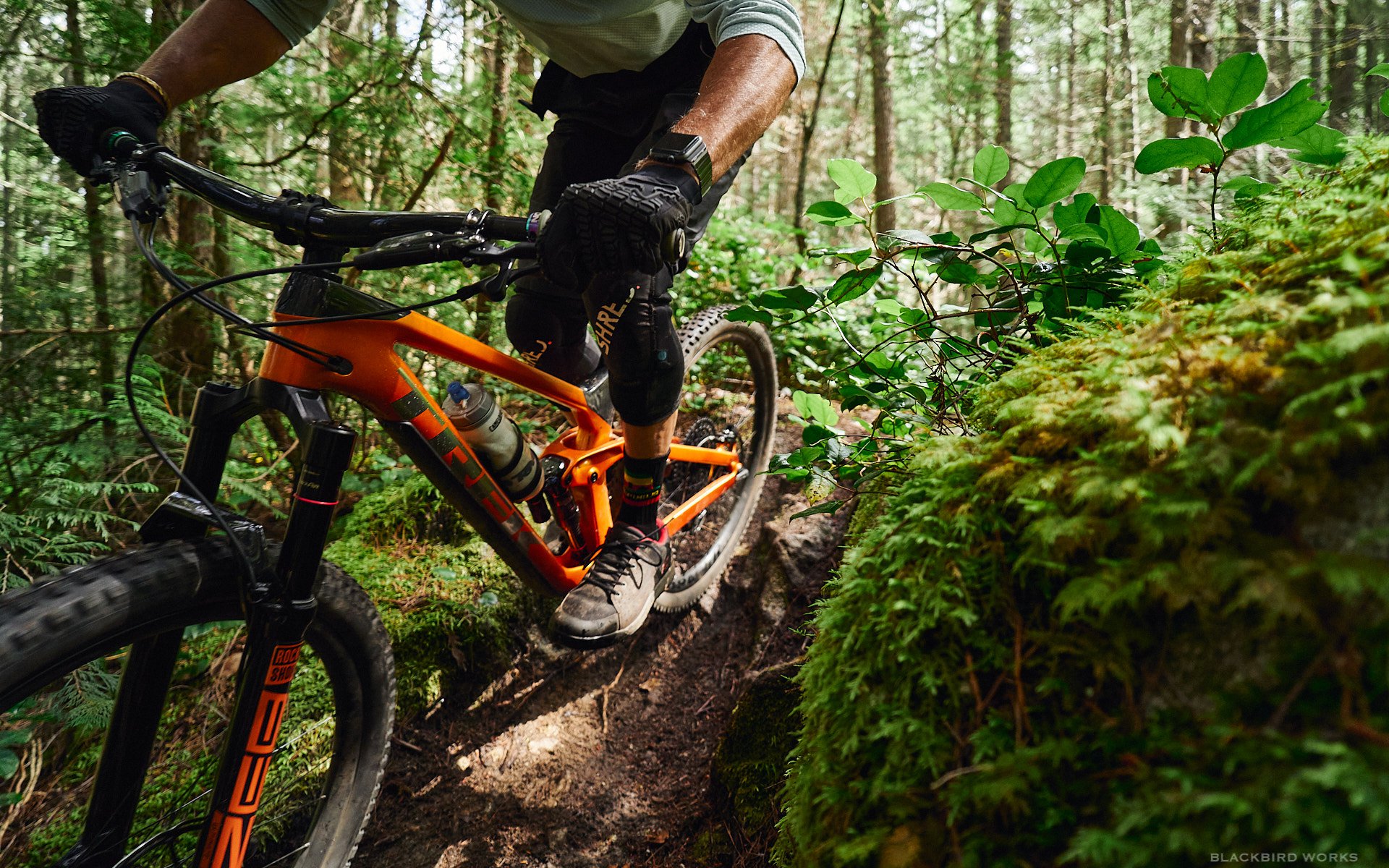
FIRST IMPRESSIONS REVIEW
Introducing the 2021 Trek Slash 9.9 XO1
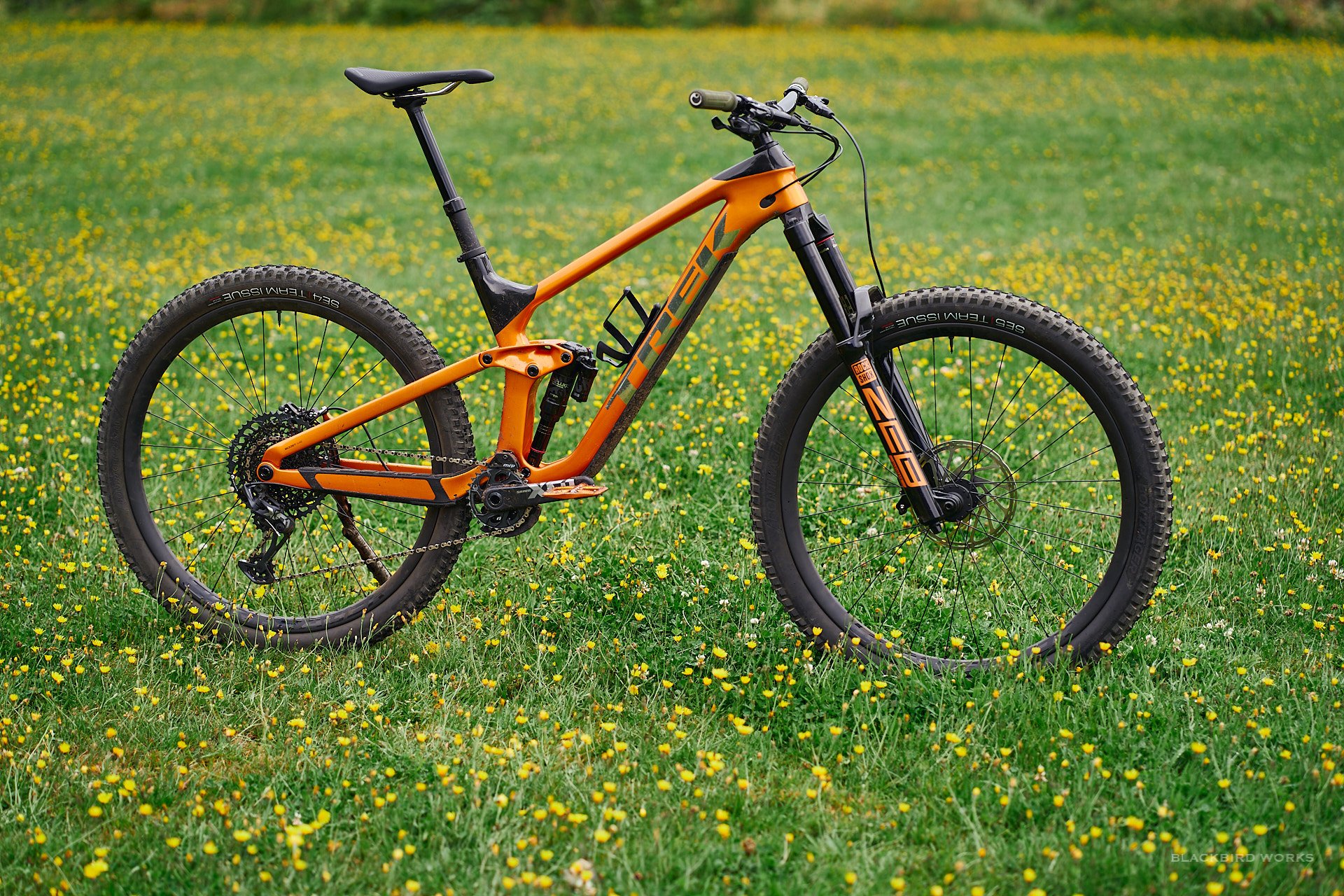
When Trek's Slash was released in 2016 it was an outlier. It wasn't the only long travel 29er available, but Trek fully committed to big wheels and there was no tweener-wheeled sibling following behind. This was bold at the time, but anyone with a stopwatch could see the future; this was an enduro race bike and big wheels are faster. It's possible they lost some sales at the time, but not enough to change course and release go back to a 650b version down the road; since the Slash 29 was released in 2016, there hasn't been a Slash with smaller wheels.
Slash Highlights
- New longer, lower, slacker geometry with reach numbers growing 30mm on the XL frame in low position and head angle moving from 65.1º to 64.1º
- Travel increased by 10mm to 170 up front and 160 rear
- Effective seat angle Increased 2º while actual seat tube angle increases by 1º
- Upper models equipped with new Rock Shox Super Deluxe thru shaft shock with usable open setting
- On board storage compartment in down tube for carbon and aluminum models
- Full length down tube guard protects against debris and truck tailgate damage
- threaded bottom bracket on all models
- Knock Block 2 increases steering from 58º to 72º and can be removed without fear of frame damage
- 34.9 mm post diameter increases strength and can improve longevity and performance of dropper post
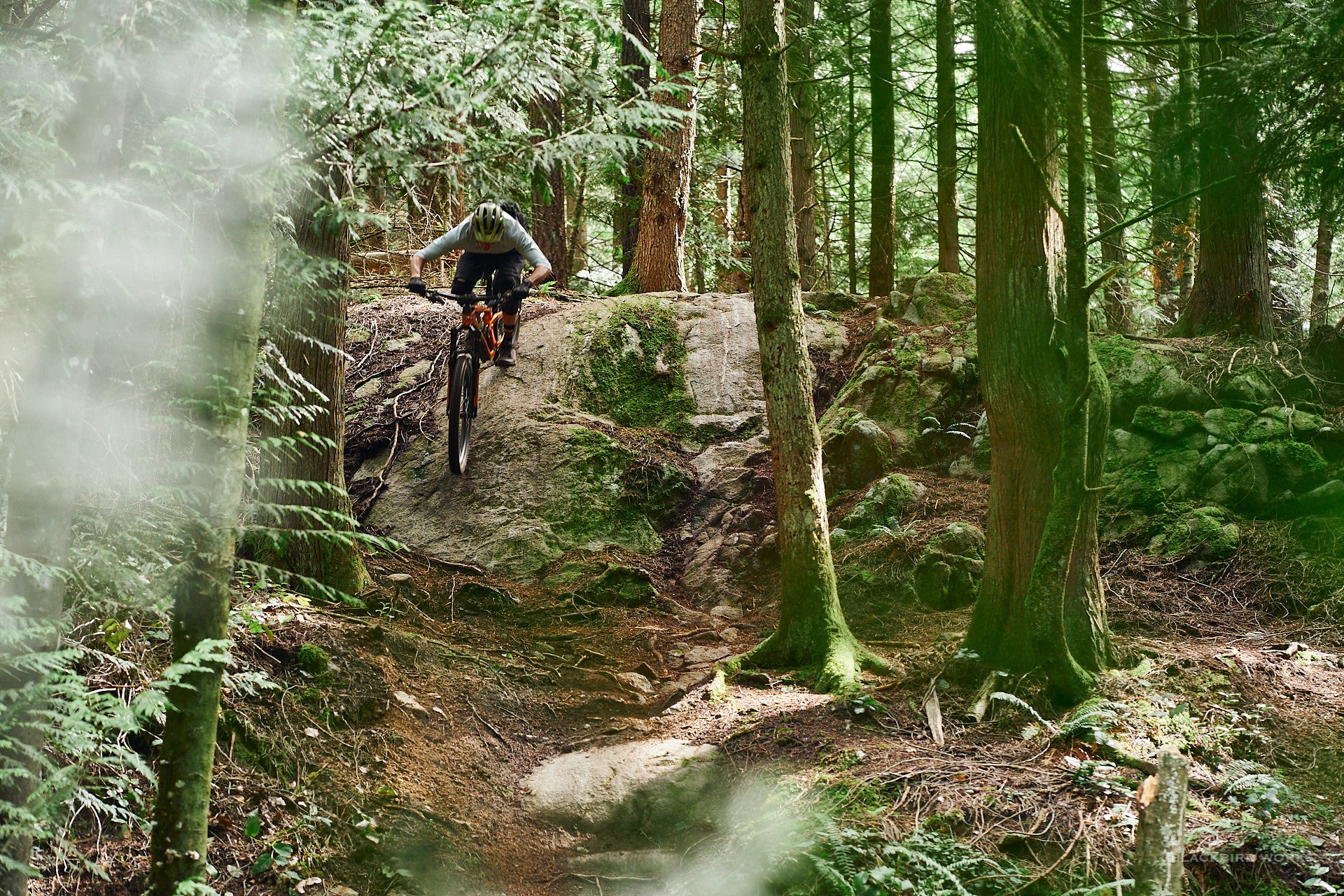
I felt pretty confident entering bomb holes at the bottom of rock faces on the Slash.
The Slash was released as the geometry revolution was gaining steam and it wasn't long before the geo numbers started to look a little geriatric. The reach of the previous generation Slash in size XL is 481mm in the low position. The XL now measures 516mm while the new large measures 486mm. After falling a little behind, because of a long product cycle, you'd think Trek would want to push the envelope a little but there aren't many numbers here that would make the geo nerds salivate; in low position the head angle tips back to 64.1 from 65.1 while the effective seat angle (always a misleading number for long-legged folks) moves from 73.6 to 75.6. The wheelbase grows from 1219mm to 1264mm. If you are eyeing up a Pole or a Geometron these numbers aren't going to turn your head, but they aren't entirely off the back either.
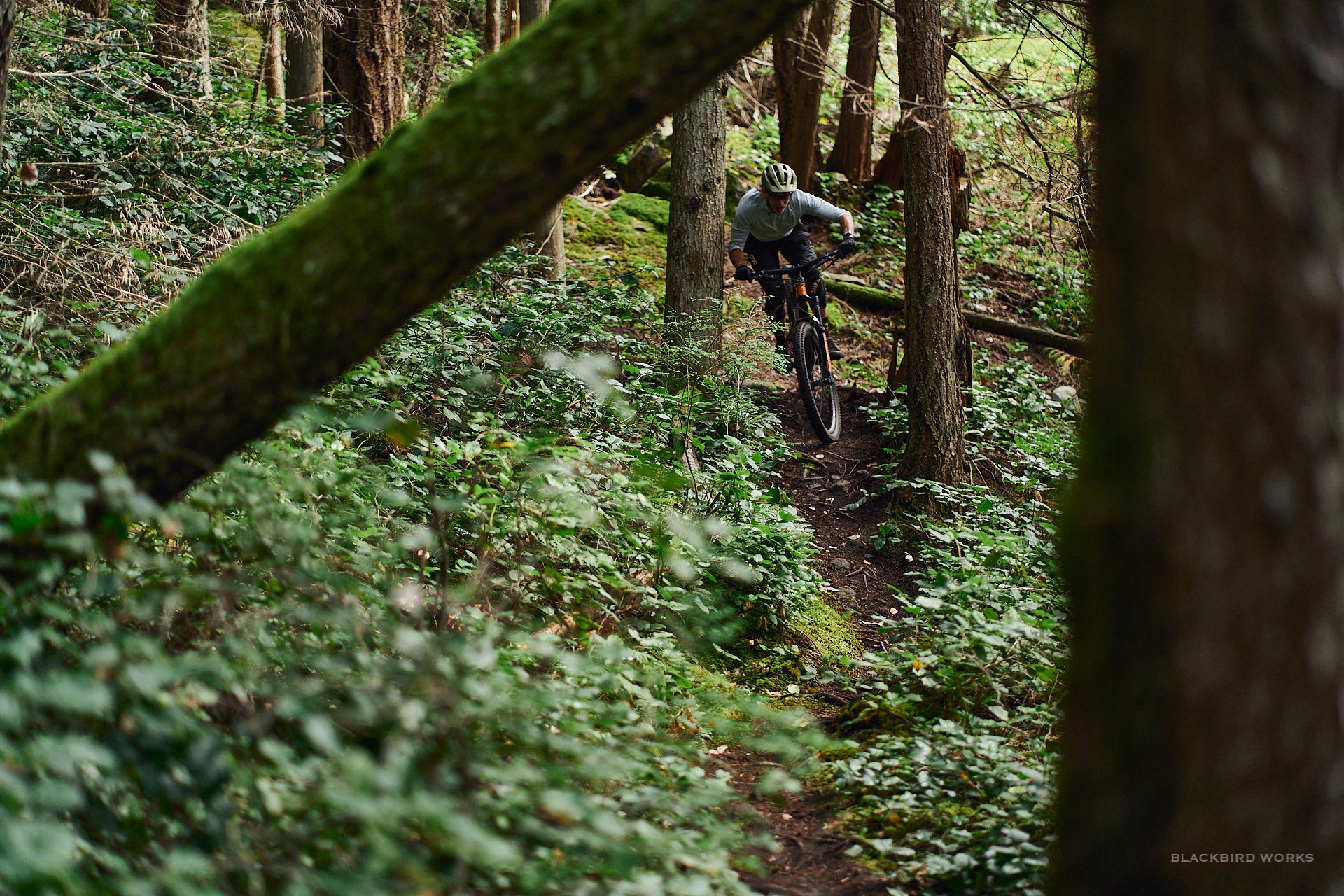
Surfing Salal.
Another change is weight. This is one category that seems to be moving backward for bikes of this ilk and a Slash 9.9 of the previous generation might have been sub 30lbs/13.5kg without pedals. The model we were sent was just over 32lbs/14.5kg out of the box without pedals, which might be a good thing. The original Slash we tested was damaged when it was in Perry Schebel's pantry. His theory at the time was that a can of food fell and hit the top tube, puncturing the carbon fibre clean through. While this was easily fixed locally, it made me wonder about what sort of forces the frame would be able to withstand.
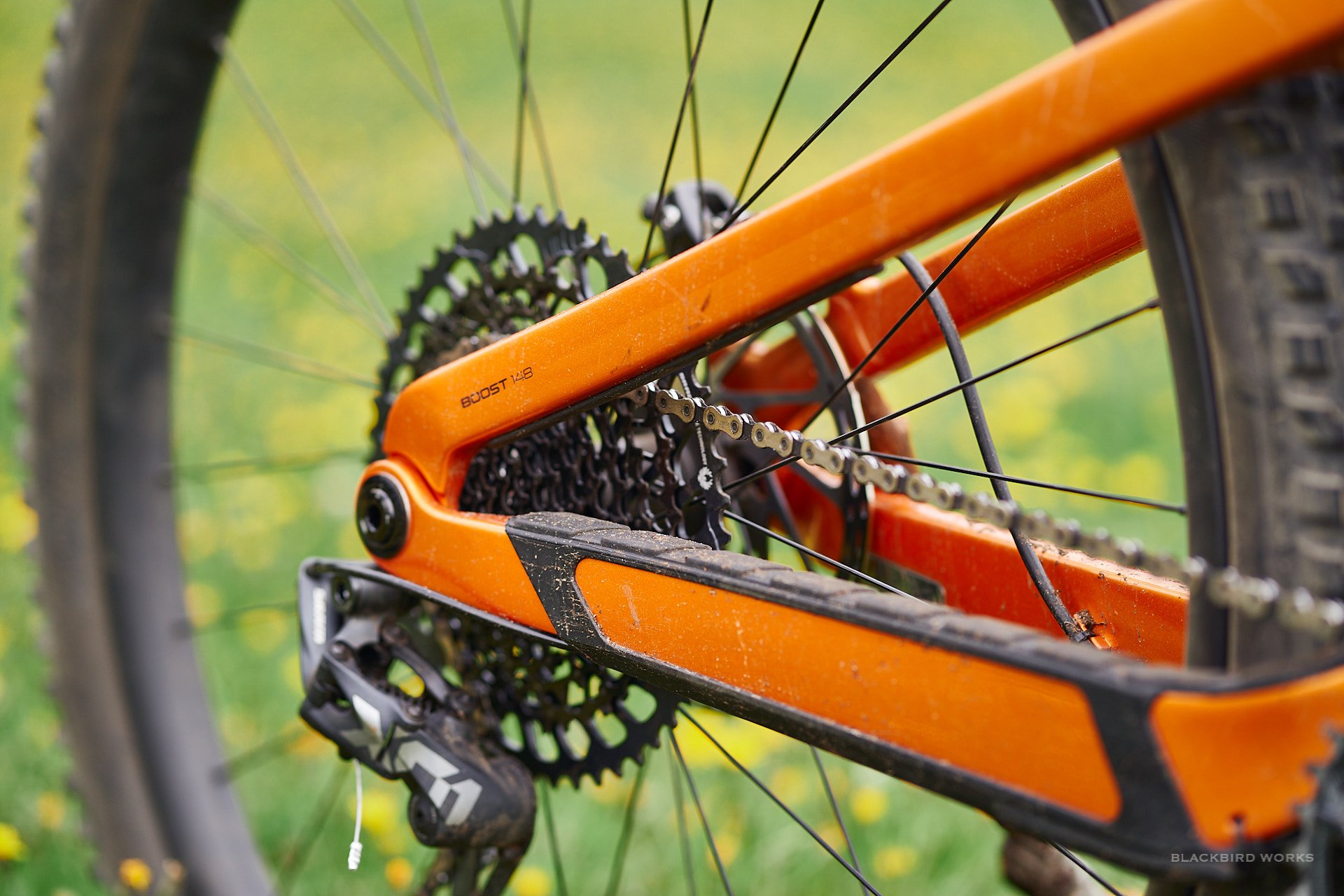
The chainstay is well protected and the material effectively deadens sound.
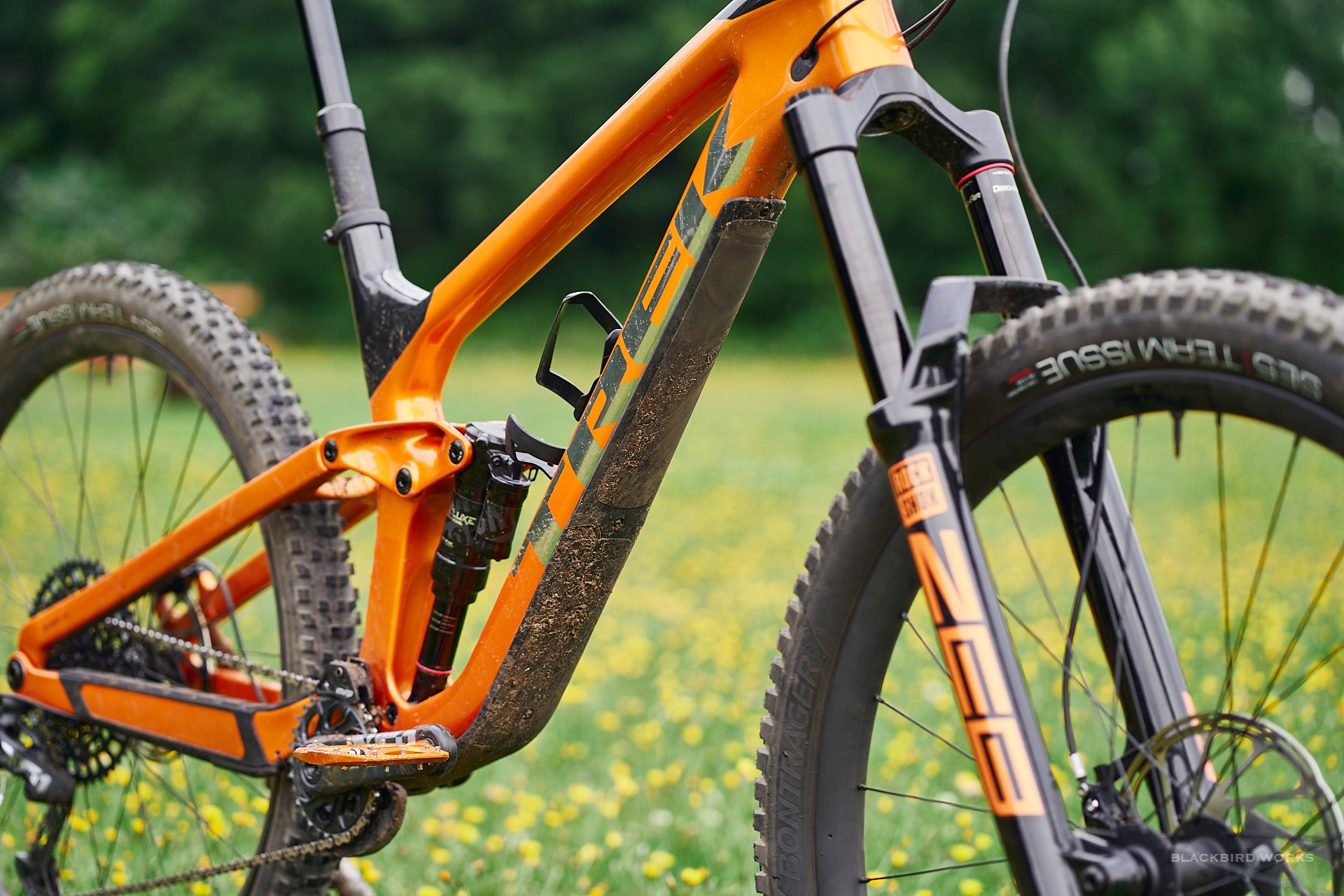
Bolts hold the down tube protector in place and it can be removed or replaced.
Frame Features
Trek has done a solid job protecting the frame, with a sturdy full-length down tube protector attached. There's no need to worry about trail shrapnel or truck tailgates any longer. The chainstay protector covers the top and bottom of the stay with a thick material that effectively deadens sound. Both of these armouring devices appear to be replaceable and removable.
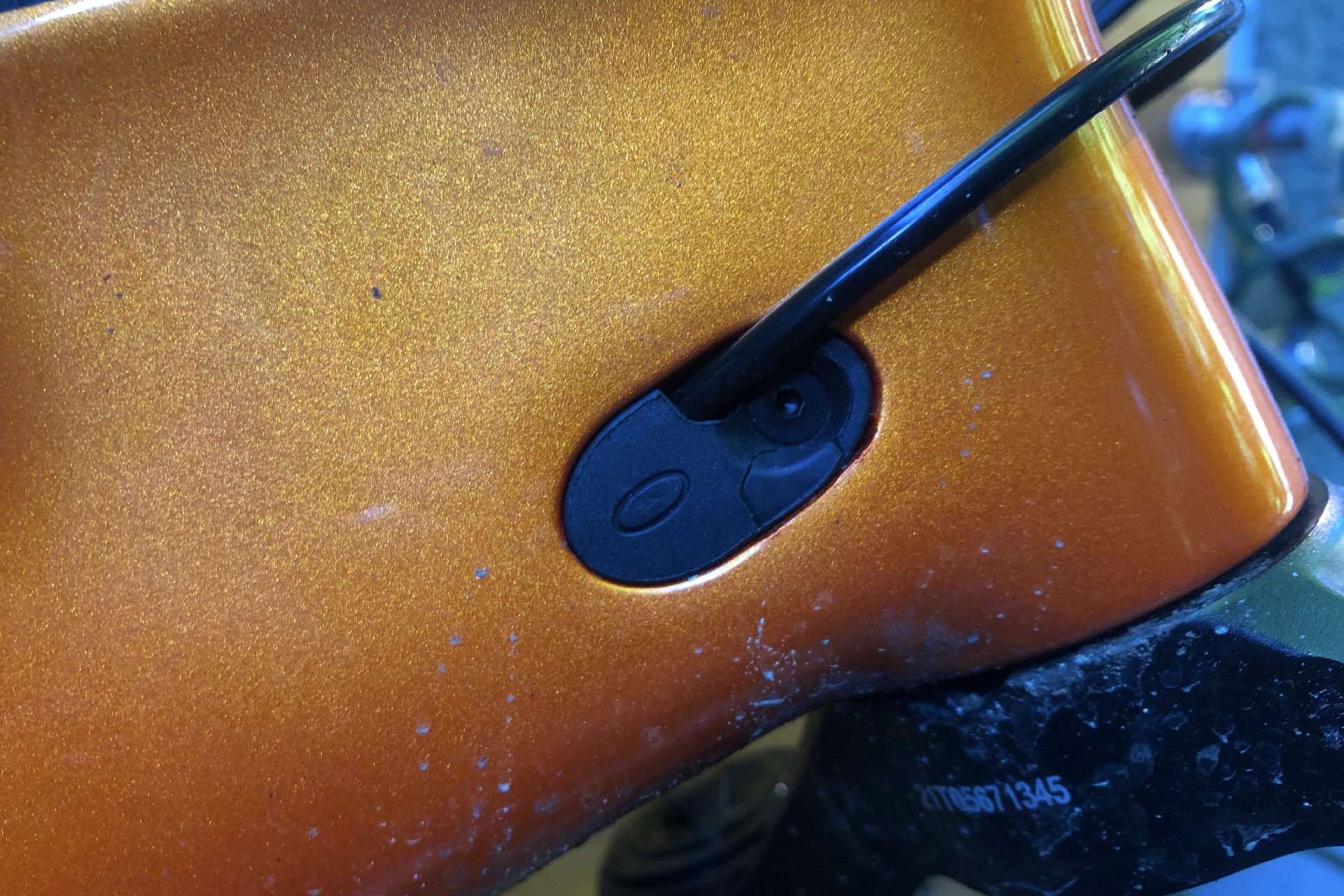
Tidy modular hatches for cables and lines.
Cables and lines are kept in place by tidy little hatches, each secured with a bolt. Each hatch has space for two lines but can be sealed up if that is required, for riders who choose SRAM's AXS wireless components, for example.
There is a removable 6mm lever attached to the rear axle that also fits the front axle for quick wheel removals. If you prefer a clean look you can leave it at home and use the multi tool instead.
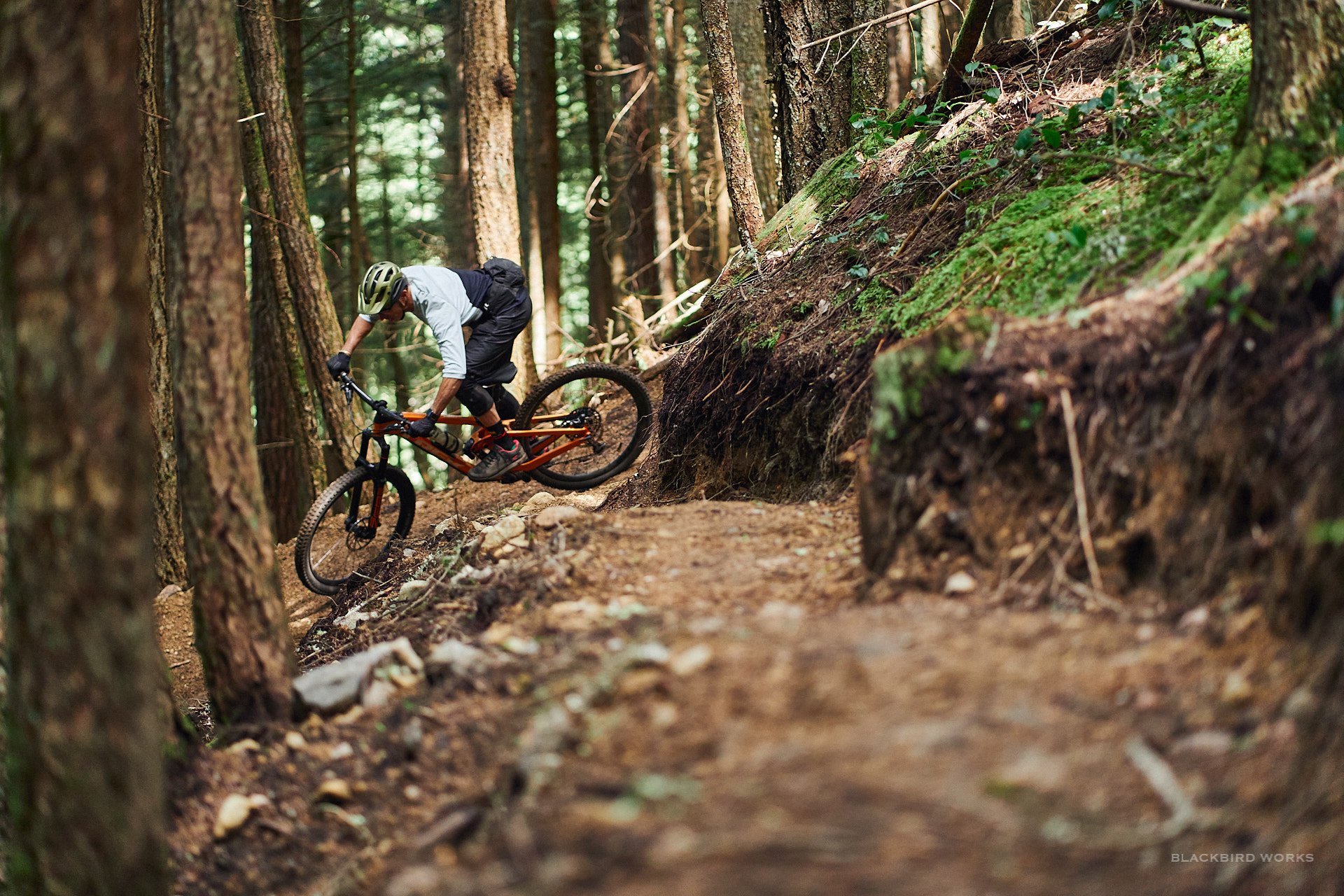
The Slash handled tight terrain well once I got a little more aggressive with my body english.
Knock Block
A feature that lives on in the Slash is the Knock Block, Trek's proprietary steering limiter that prevents the bars from turning beyond a certain angle. The previous version was a necessity because the straight shape of the down tube meant the top caps of your fork would strike the frame without Knock Block to stop it. Now that the bike has been stretched out, the fork clears easily, so why did Trek persist with KB? I was told this was because some riders like the feature, and it's not without benefits; you can cut your cables and lines extremely short without fear of damaging them, and in a crash you are less likely to yank out a brake line because your bars have spun completely. The angle limit of the old system wasn't sufficient for some riders but it of course couldn't be removed. The new version allows an entirely respectable turning radius (72º in either direction or 144º total while the previous Slash was only 58º or 116º in total) and it can be removed if you choose, although I haven't been able to do so yet.
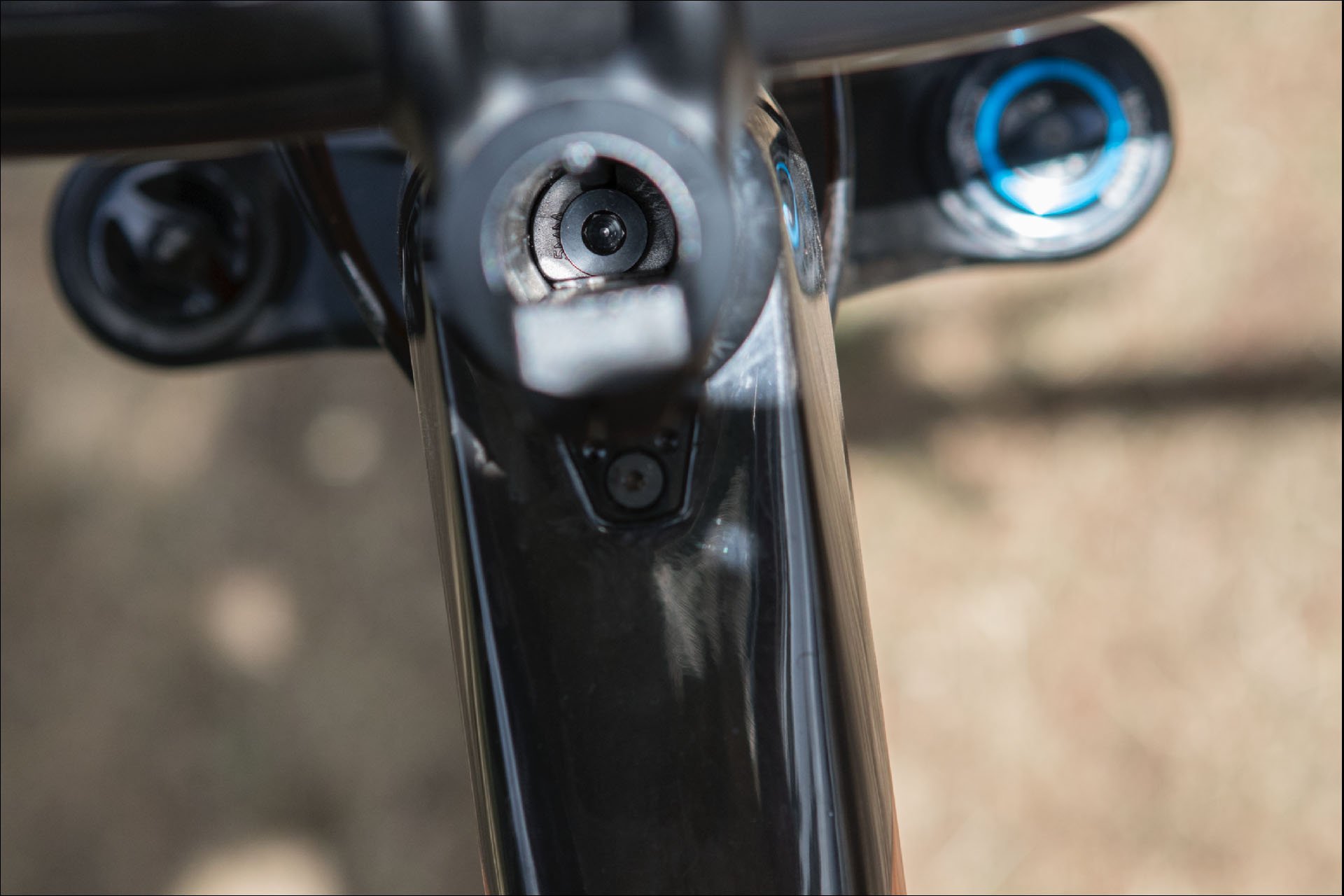
Downforce for the headset is provided by a bolt that sits deep in the steerer. If your headset comes loose on the trail you'll need to tighten it from below because your multi-tool won't reach down that far. (earlier I suggested you'd need to bring a longer hex, but of course Trek thought of that)
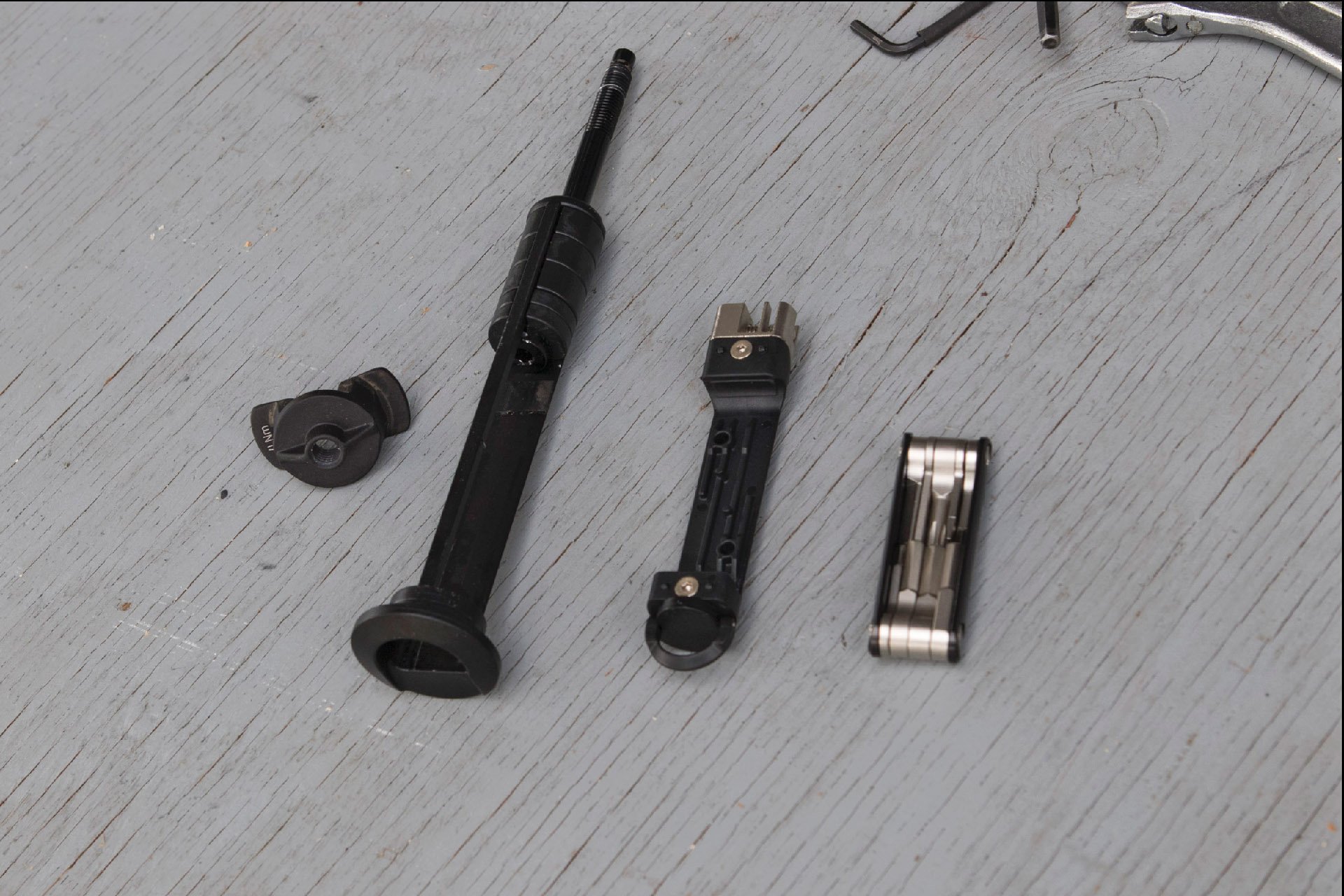
This is a slick system and it's easily removed when required.
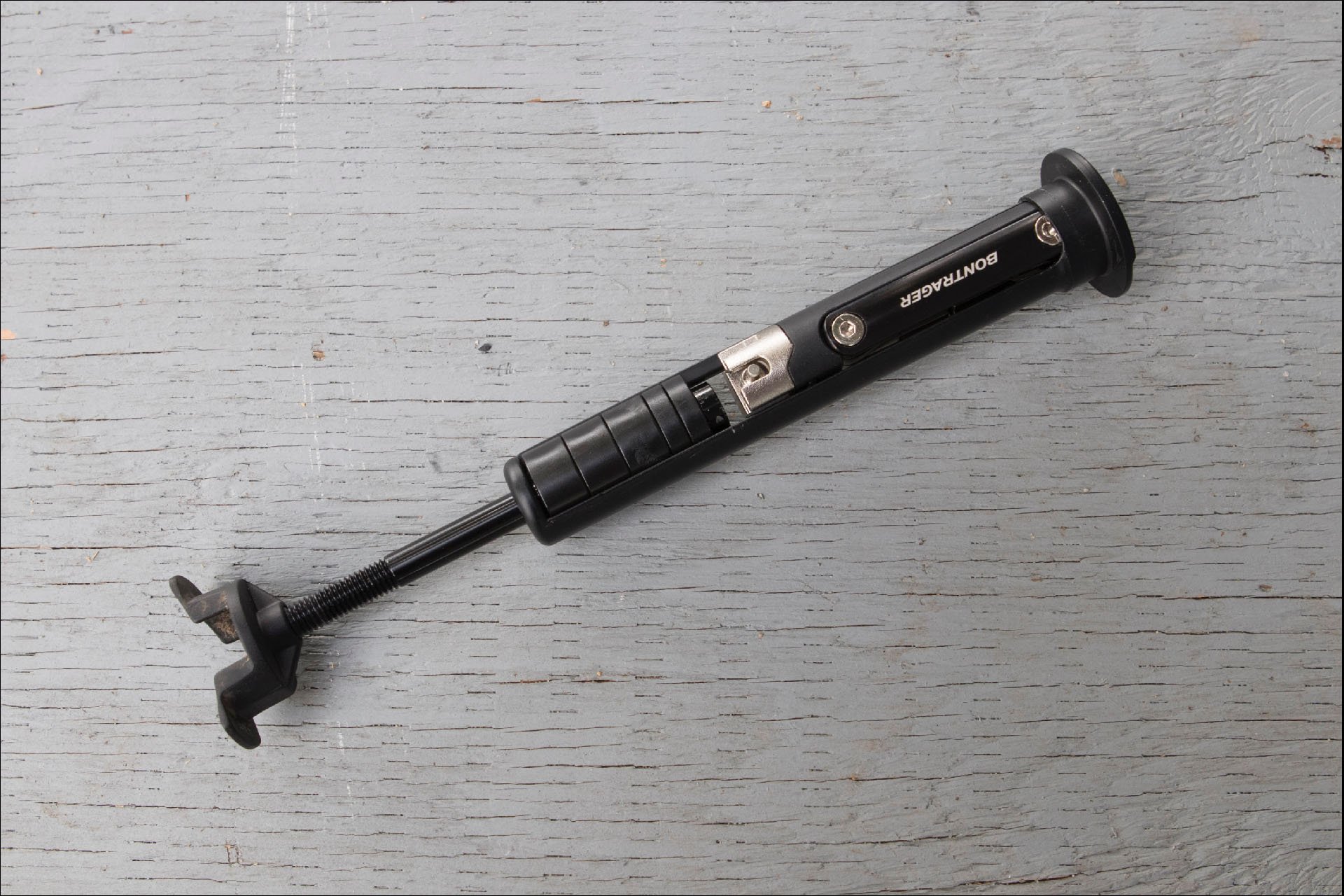
The entire assembly for integrated storage. For the first five or six rides I was unable to remove the tool caddy with my bare hands, even after applying some lube. Since removing the mechanism for these photos it has come out easily.
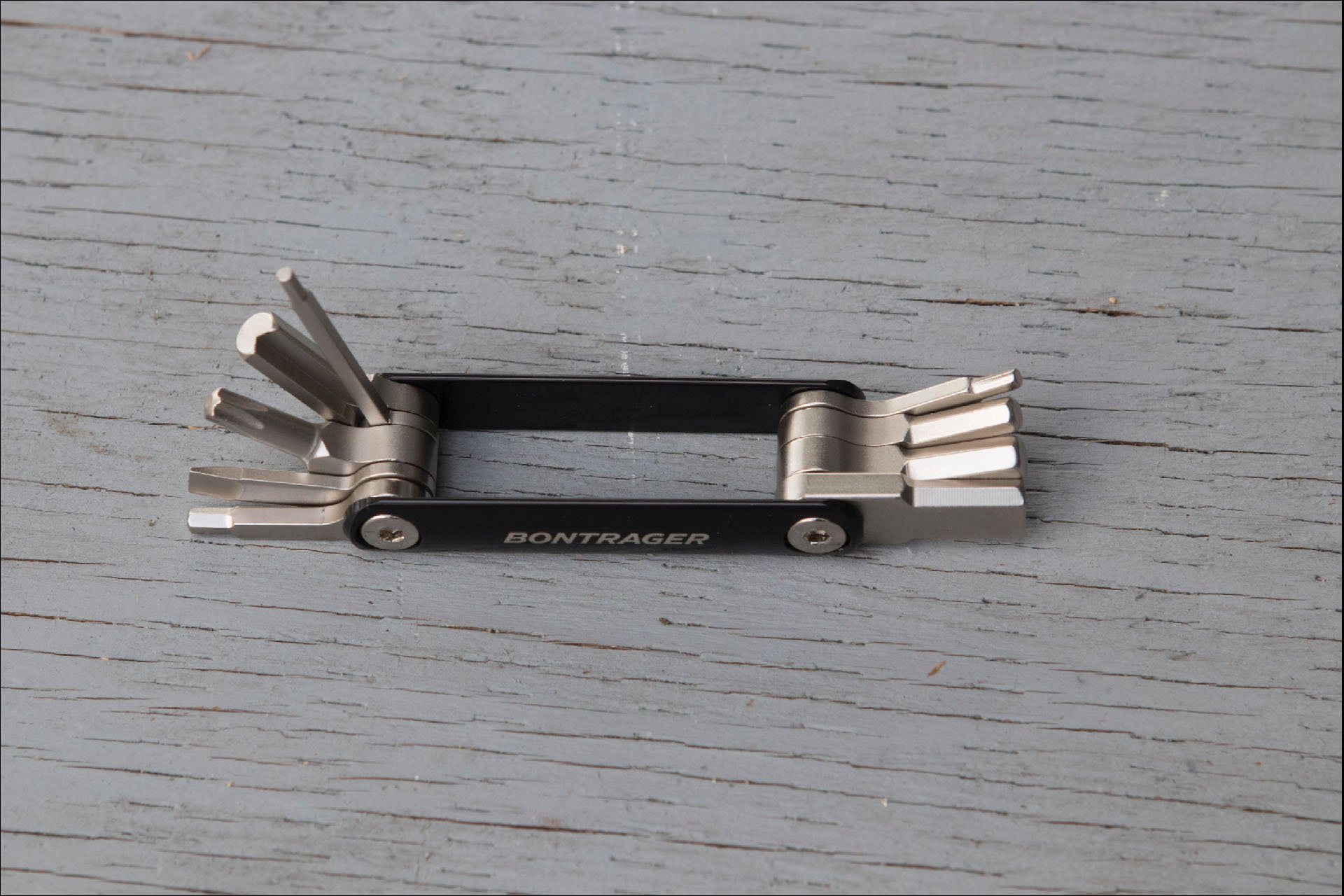
The multi has 10 different tools and can deal with most issues on your bike. There are hex keys covering 2.5-8mm, a slot screwdriver and a T25 Torx. The 2.5 nests within the 6mm and the 8mm is flattened but it works just fine.
I tried to remove the Knock Block with an appropriately-sized 2.5mm hex key, but the fitting felt soft right away. I was using an older tool so I grabbed the multi-tool from the steerer because the 2.5mm had never been used. Unfortunately it stripped despite my careful second effort. I wasn't attempting to remove it because of any perceived limitations, this was simply for testing purposes. I'll get it out eventually with some careful drilling, but can we please stop using 2.5mm fittings wherever possible? Or if a small fitting is required maybe a Torx could be used instead?
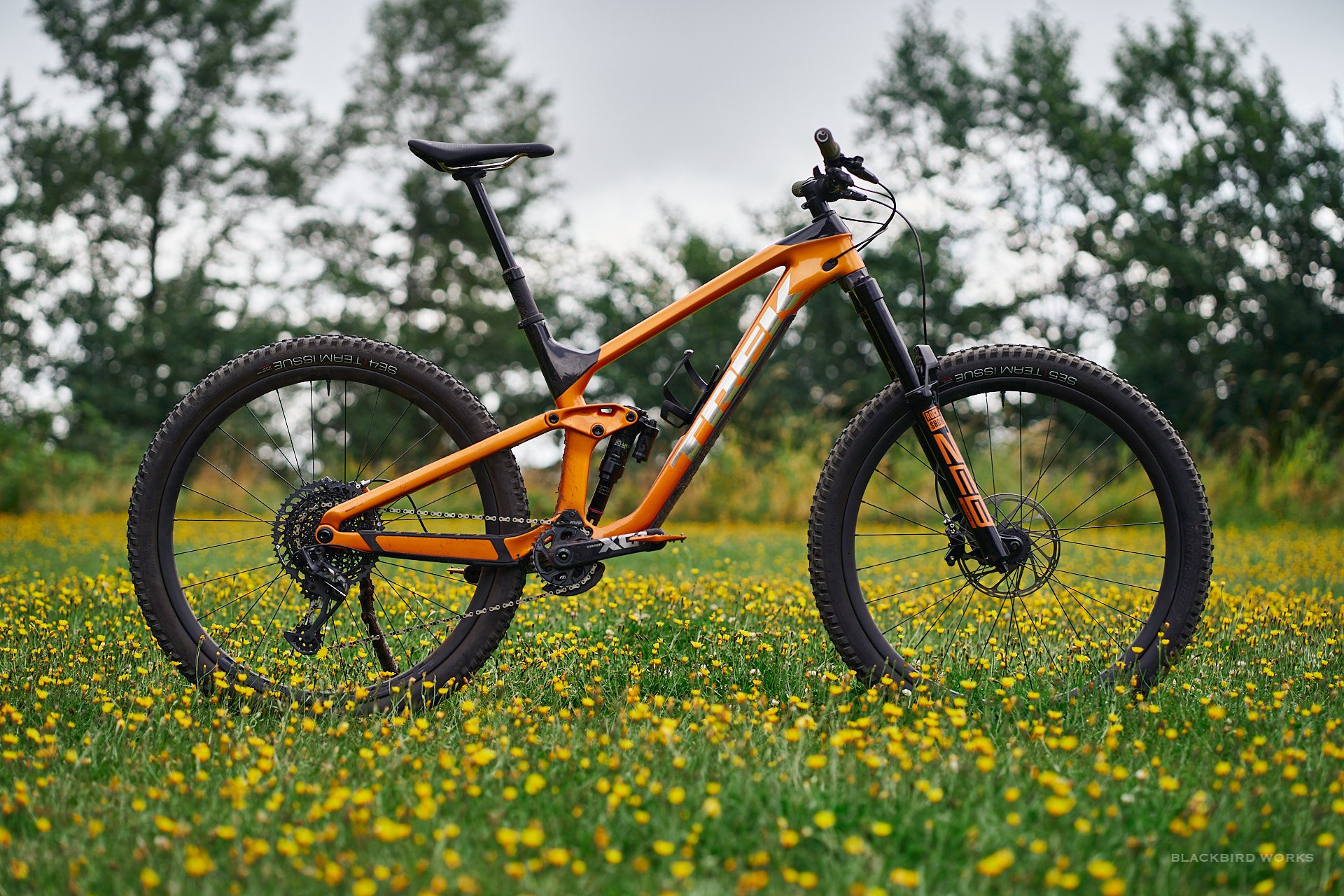
She's a looker.
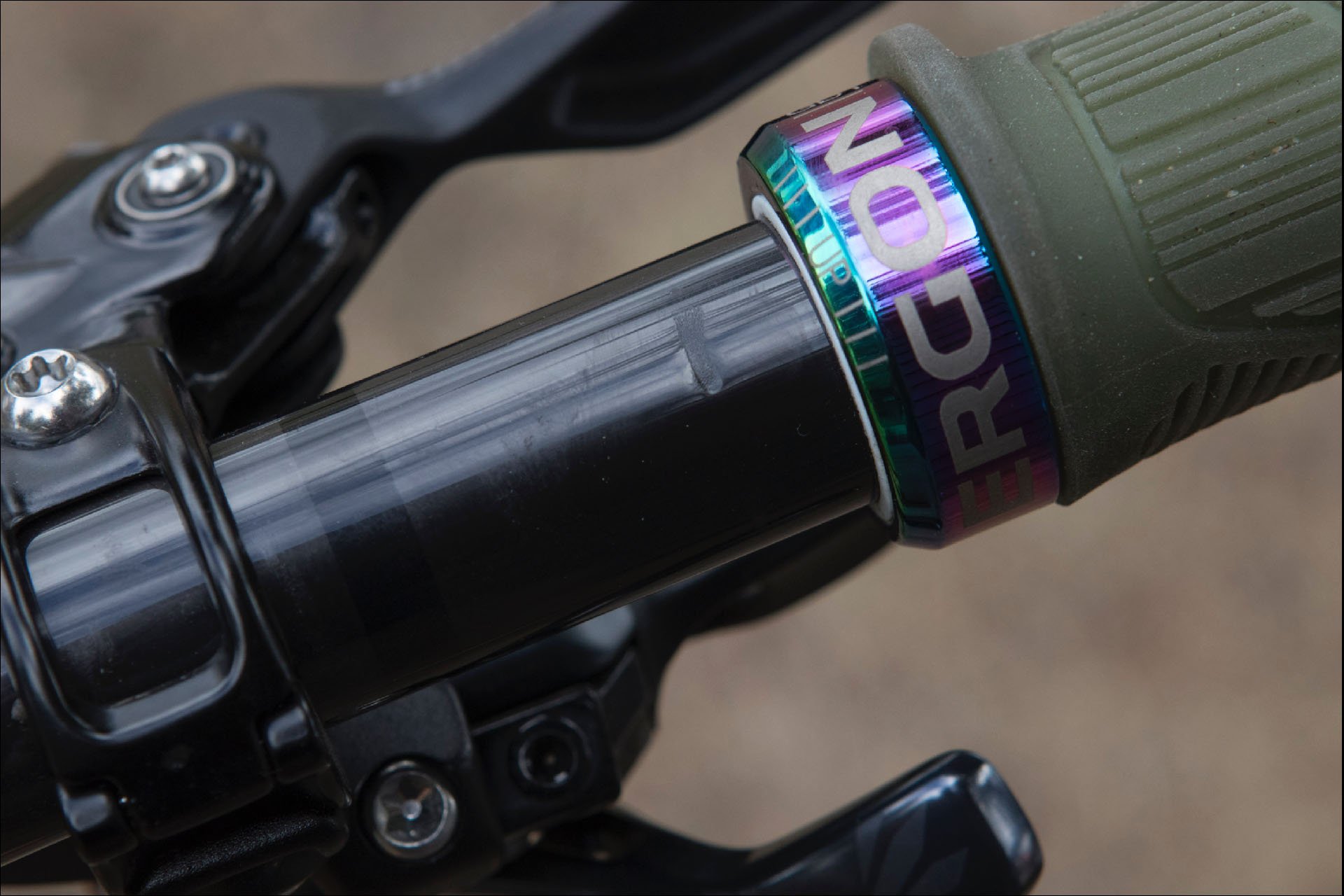
The build was good for the most part but the lever clamps were over-tightened and the bars were marked as a result. There is another mark beneath my grip and two to match on the other side. The main pivot also came loose at the beginning of a ride. Thankfully it can be accessed from the non-drive side with the 8mm on the integrated multi tool.
Integrated Storage
One of the most interesting and compelling developments for me is Trek's adoption of the down tube storage system pioneered by Specialized. When this first appeared on Trek's Fuel, I was curious about patents and intellectual property. The word from Trek is that you can't patent a hole in a frame, but clearly it wouldn't have been possible to duplicate Specialized's SWAT door. Trek's solution here is better in some ways and inferior in others. The Specialized solution is very sturdy and it feels like it's structural. The downside is that it takes some effort to open and close and it can't always be done quickly. In comparison the Trek storage door feels a little flimsy. The bottle cage moves around a little when things get bumpy but I don't think I've come close to losing a bottle. The upside is that access is fast and easy, with a simple lever used to gain entry to the pocket. Inside the tube, the Slash doesn't have a tunnel for cables and housing so it's a little less smooth and there are some zip ties to deal with, but it works fine. Storage volume seems similar but I haven't yet compared how much I can stuff in each one. One of the coolest things about the integrated storage is that Trek figured out how to add it to the aluminum models as well.
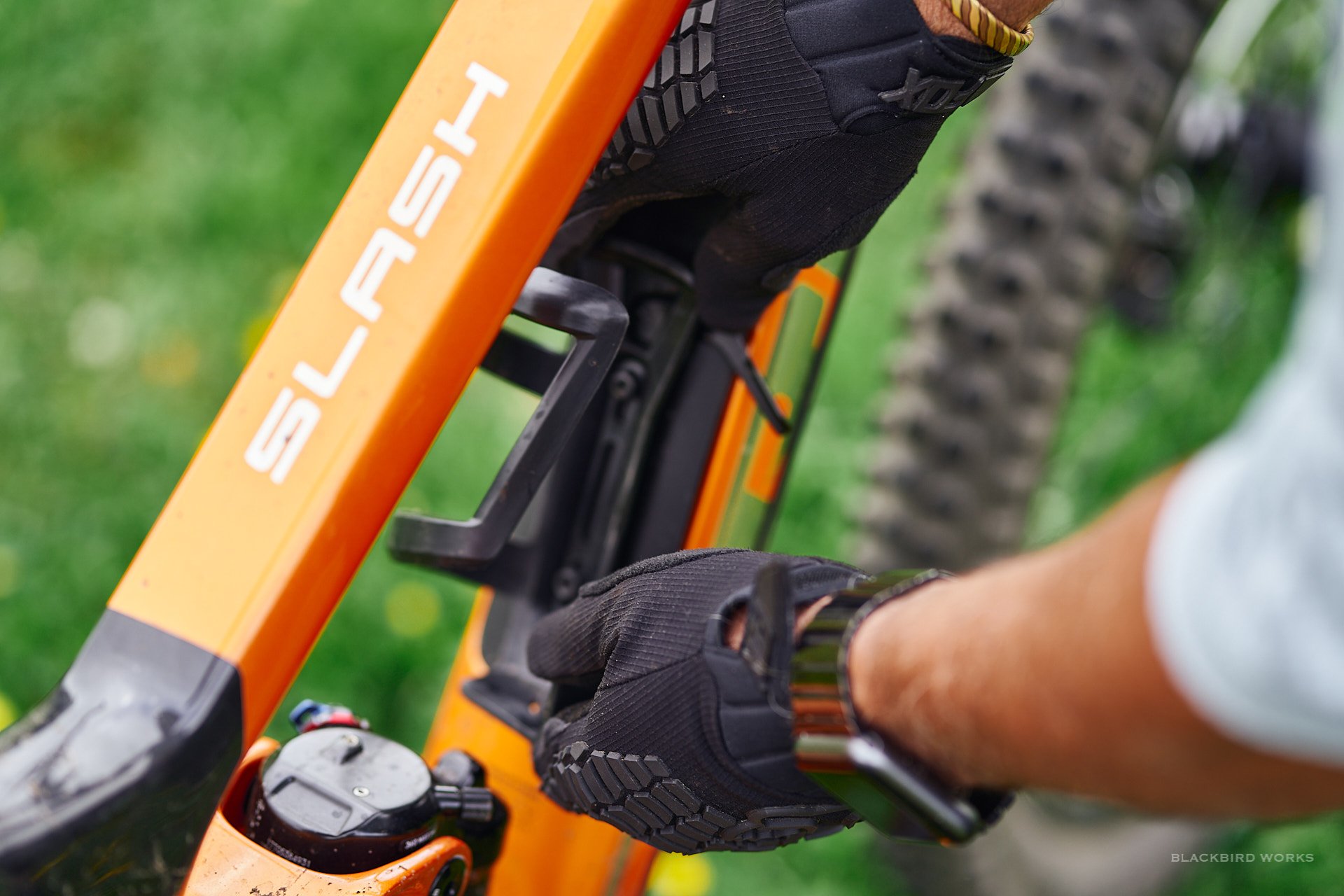
This is great news for everyone looking to ditch their pack. The cover comes off easily after a lever has been opened.
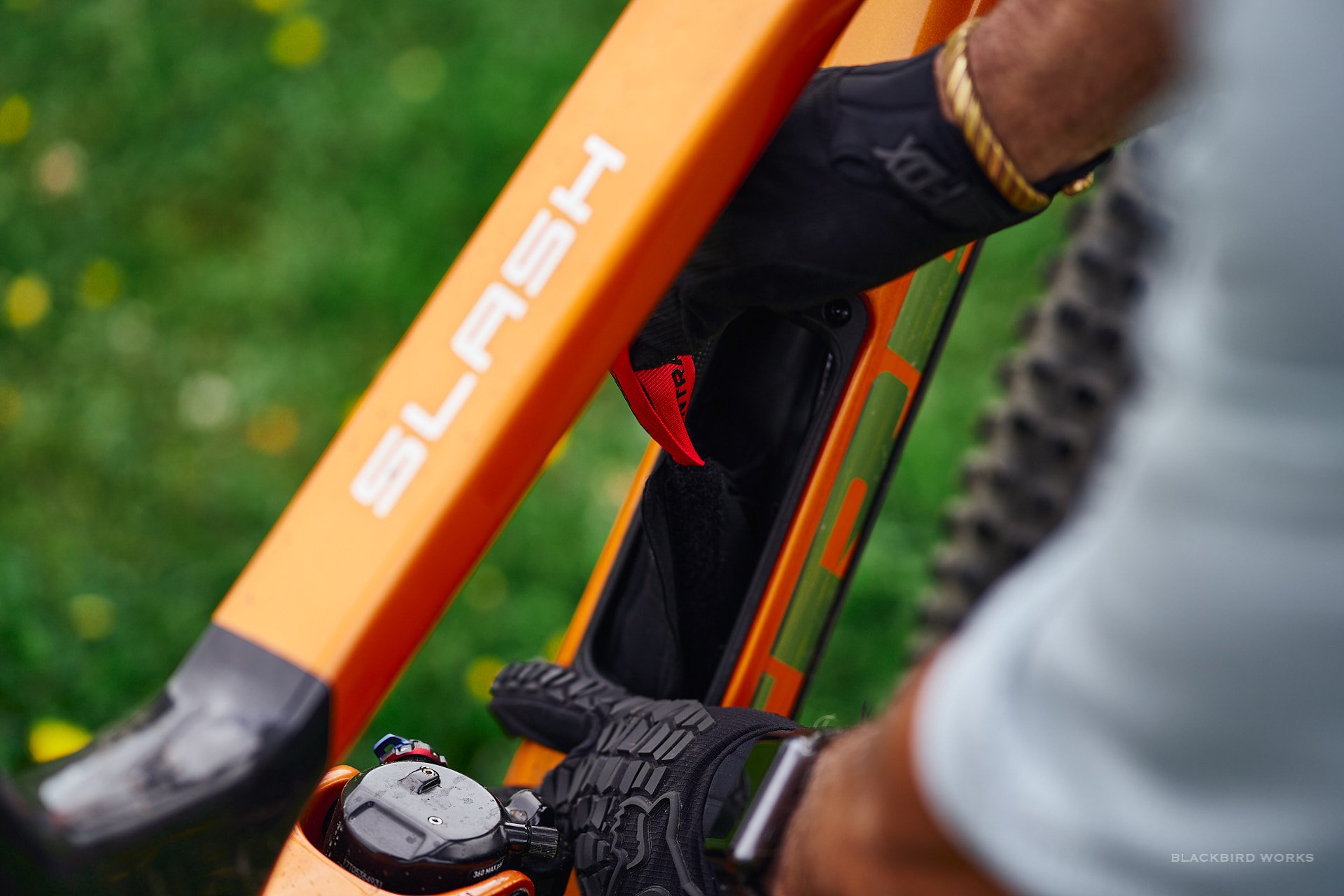
The tool wrap is easily removed.
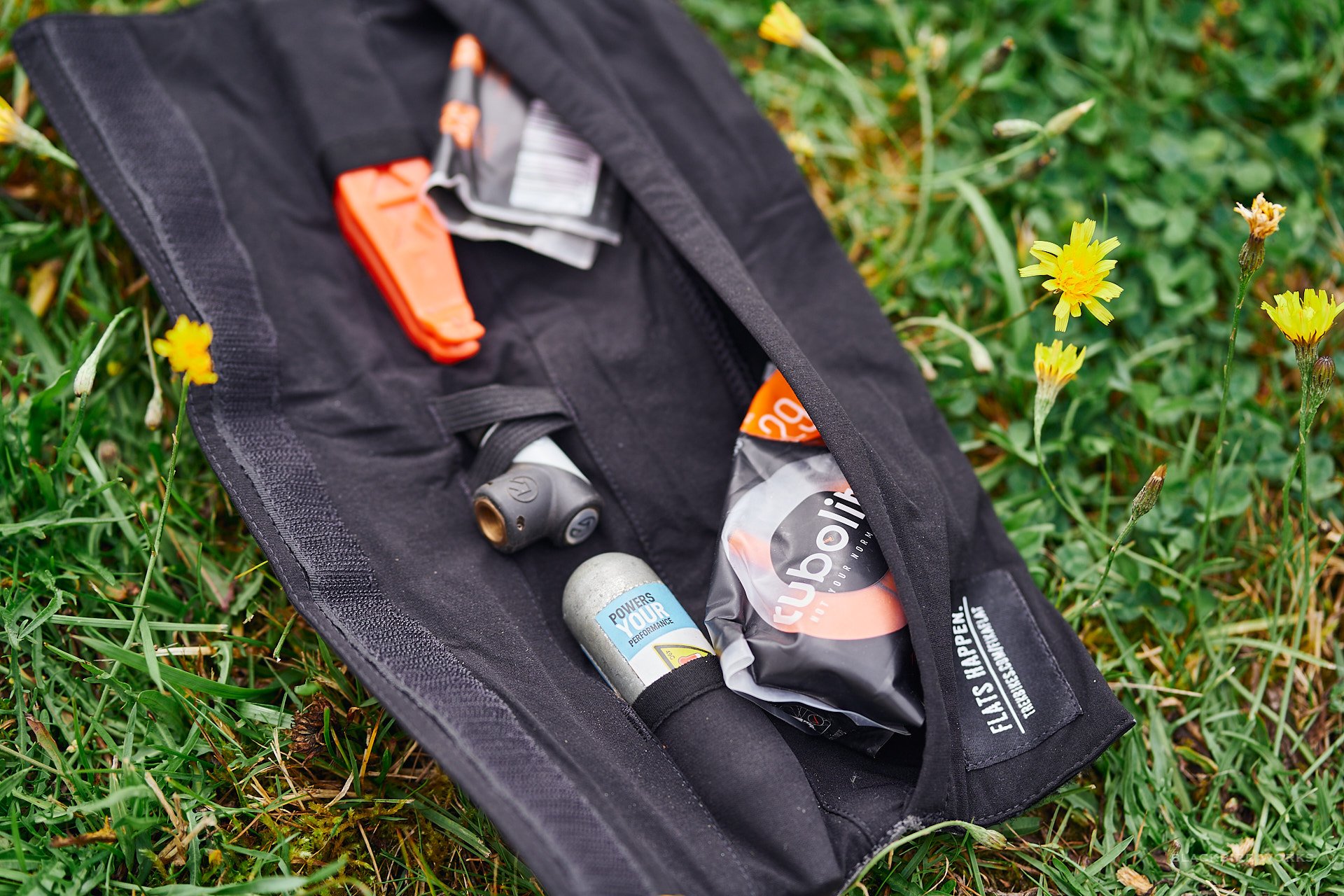
I have a relatively modest selection of gear in the wrap and thus far I have continued to wear my fanny pack.
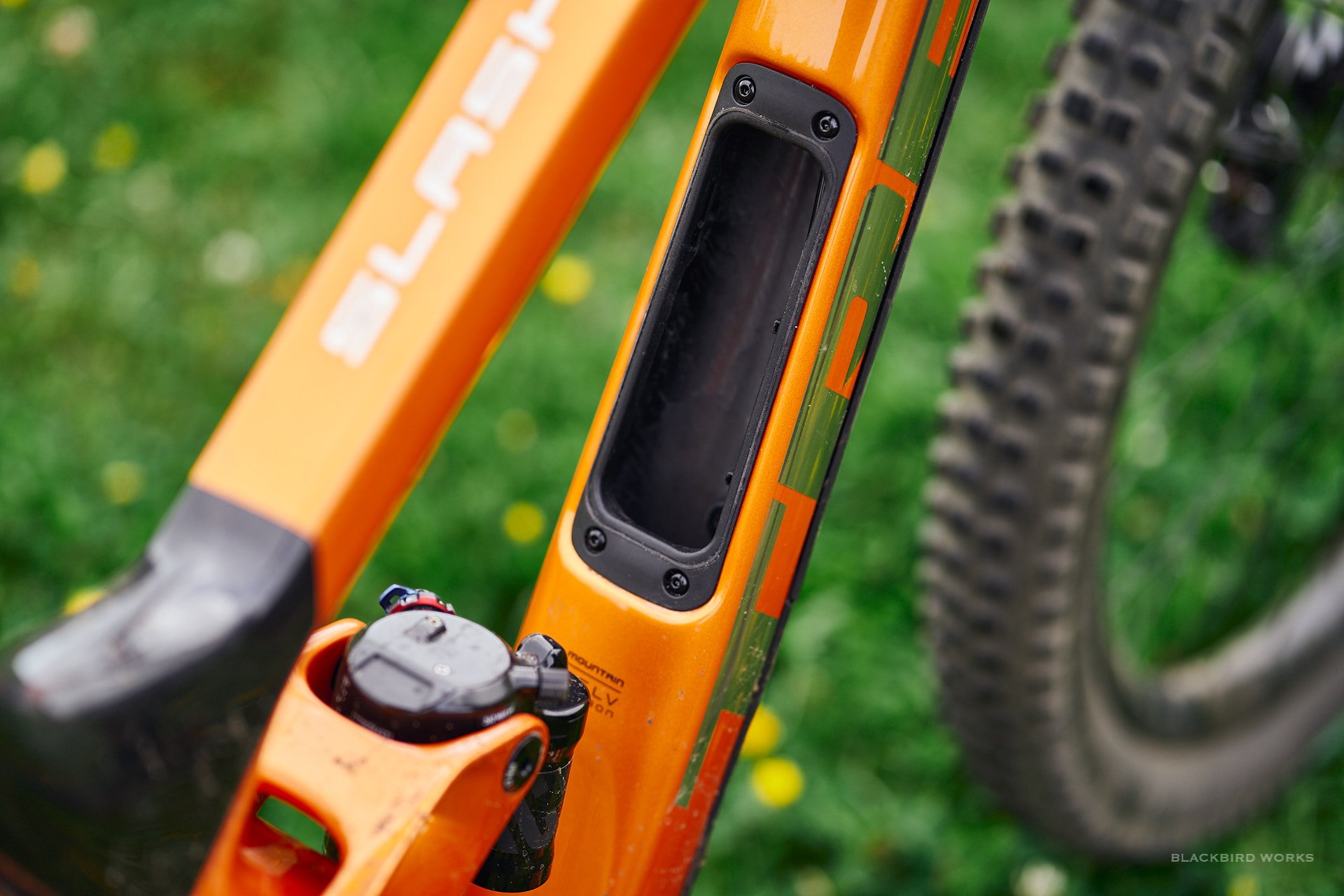
There appears to be room to stuff a small jacket above the opening but I haven't tried it yet.
Trek's sincere flattery of Specialized continues with Bontrager BITS, its steerer-stashed multi-tool, complete with chain device. It's not quite as slick as Specialized's spring-loaded system with the rotating disk cover, but now that it's broken in, it takes but a moment to gain access to the tool and I like it quite a lot. Again, there are pros and cons compared to Specialized. It's nice that the tool and the chain device are housed together, but you have the caddy to deal with when the tool is out, whereas the Specialized tool comes out on its own. Upsides are more tools on the multi and no extra extraction effort required in the event of a chain repair.
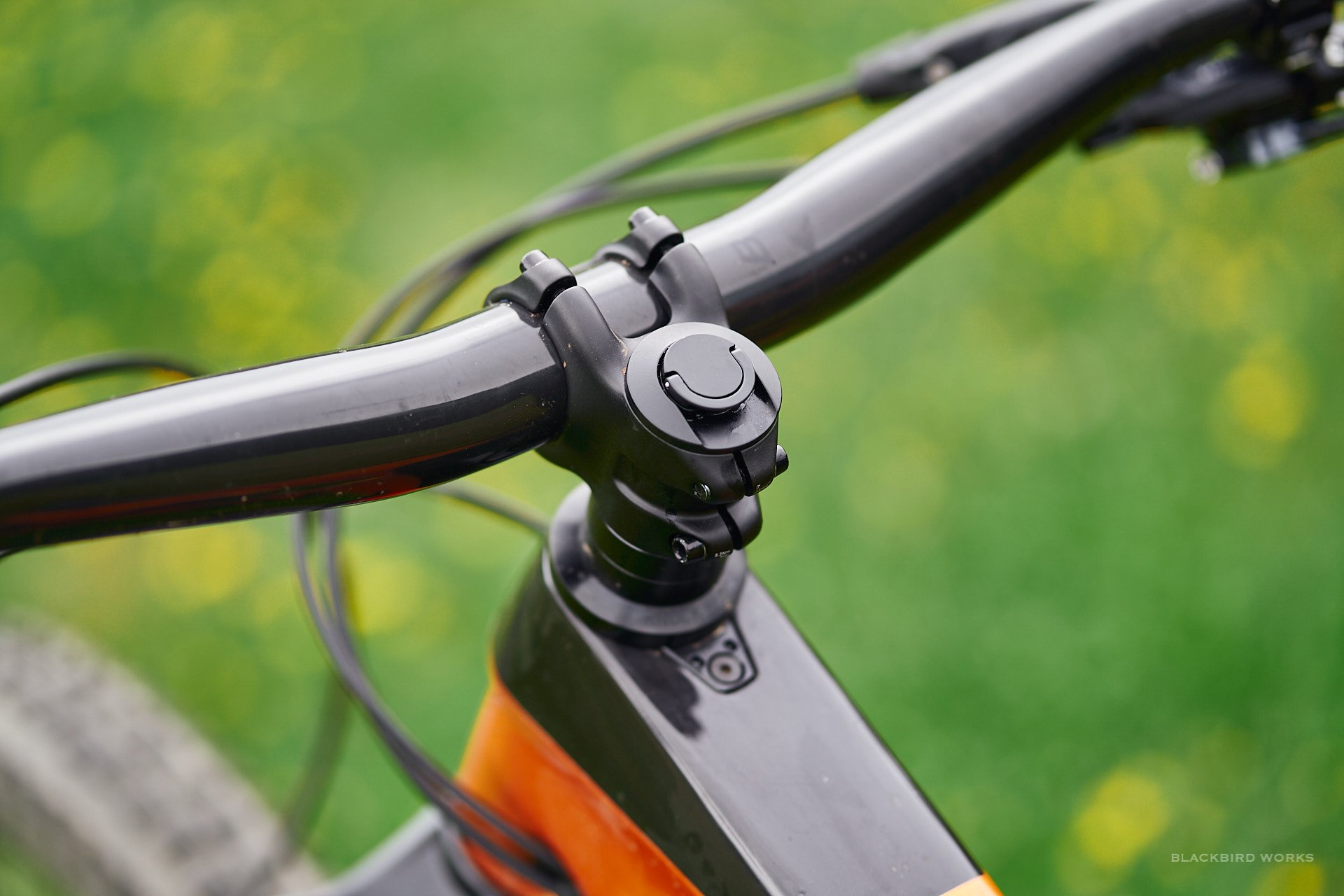
Flip up the D-ring and give it a yank and the tool and its carrier are free.
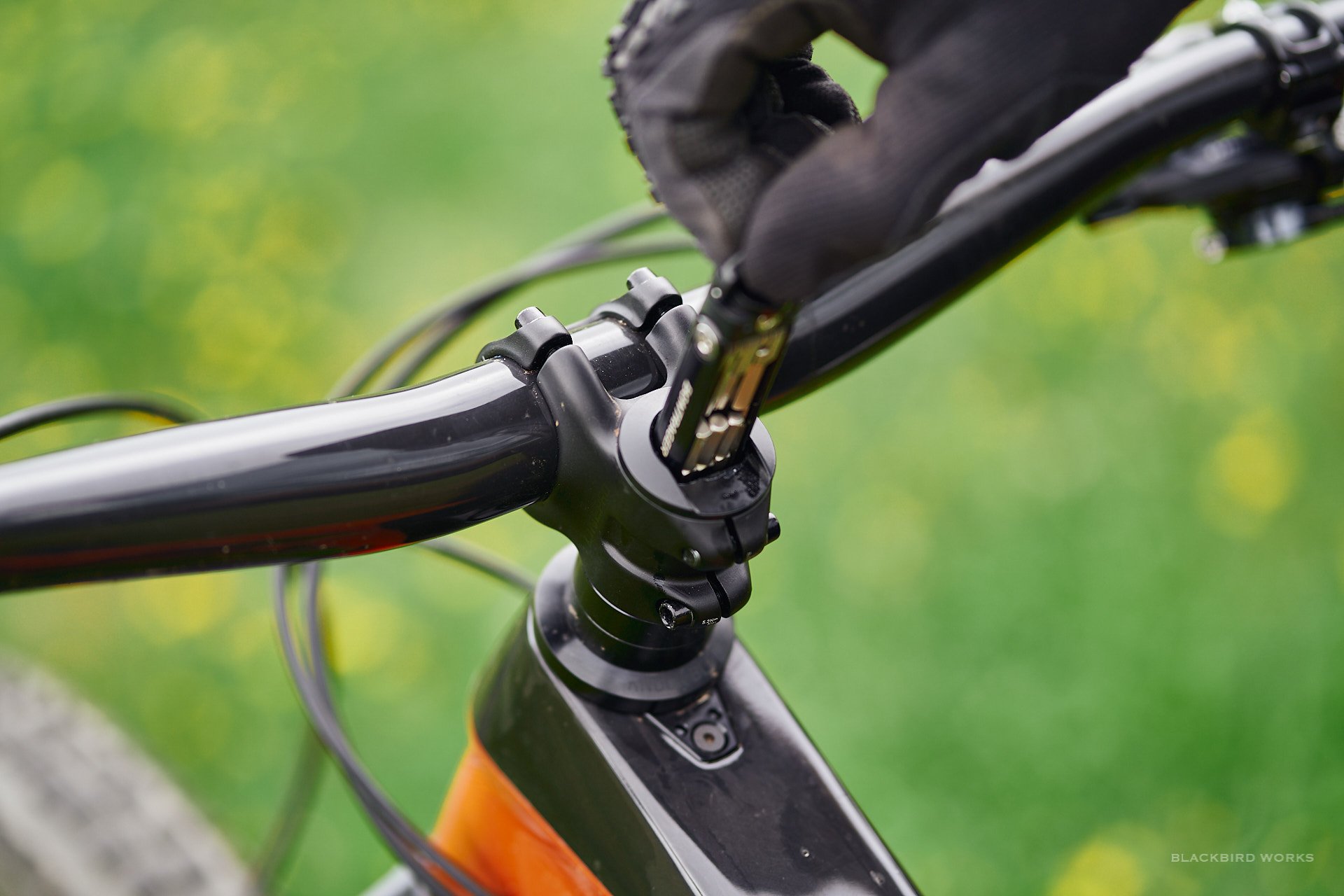
It was a little sticky at first but it moves well now.
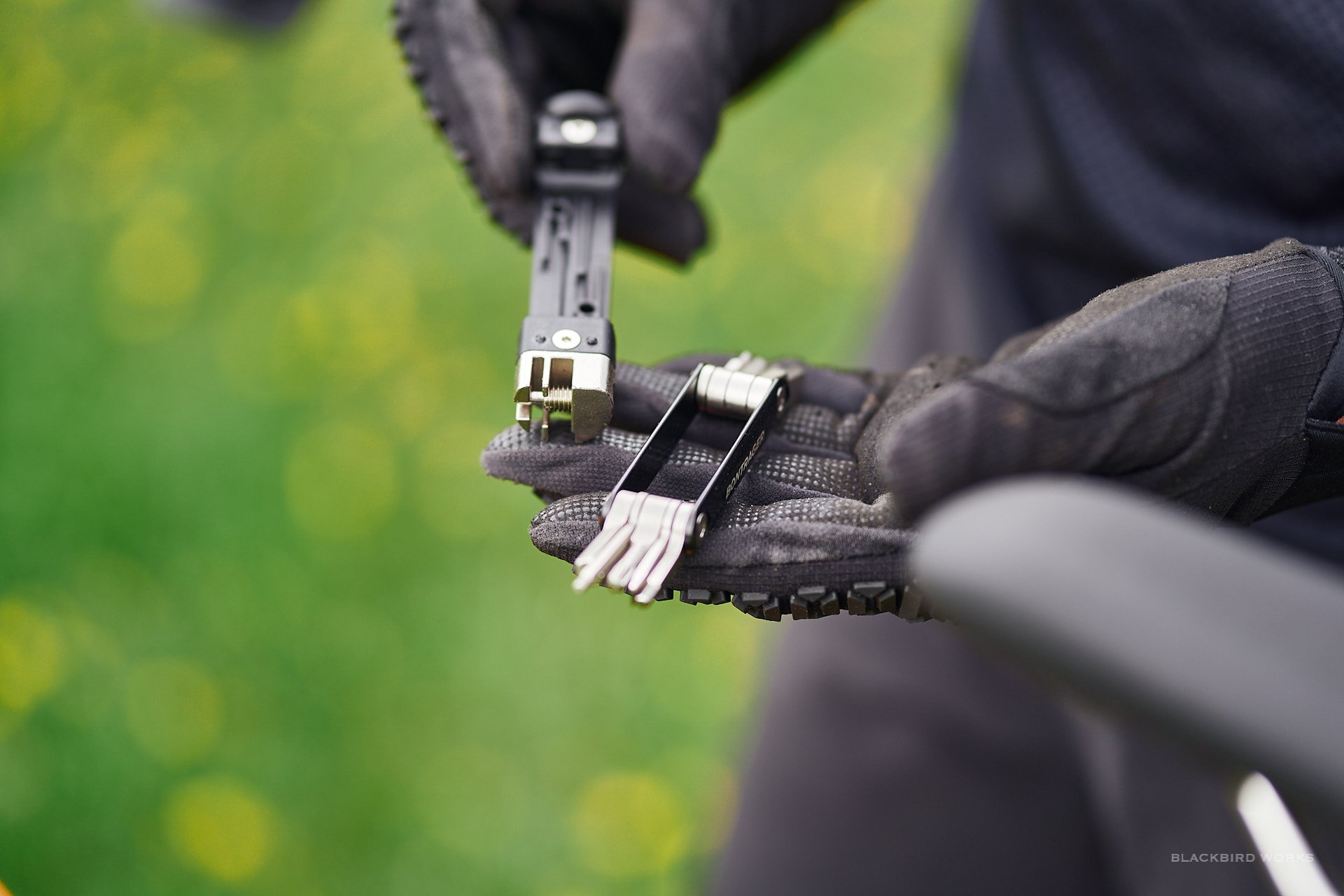
Most of what you need right on your bike. You may need at least one more tool in case your headset needs adjustment - a long 5mm hex is required.
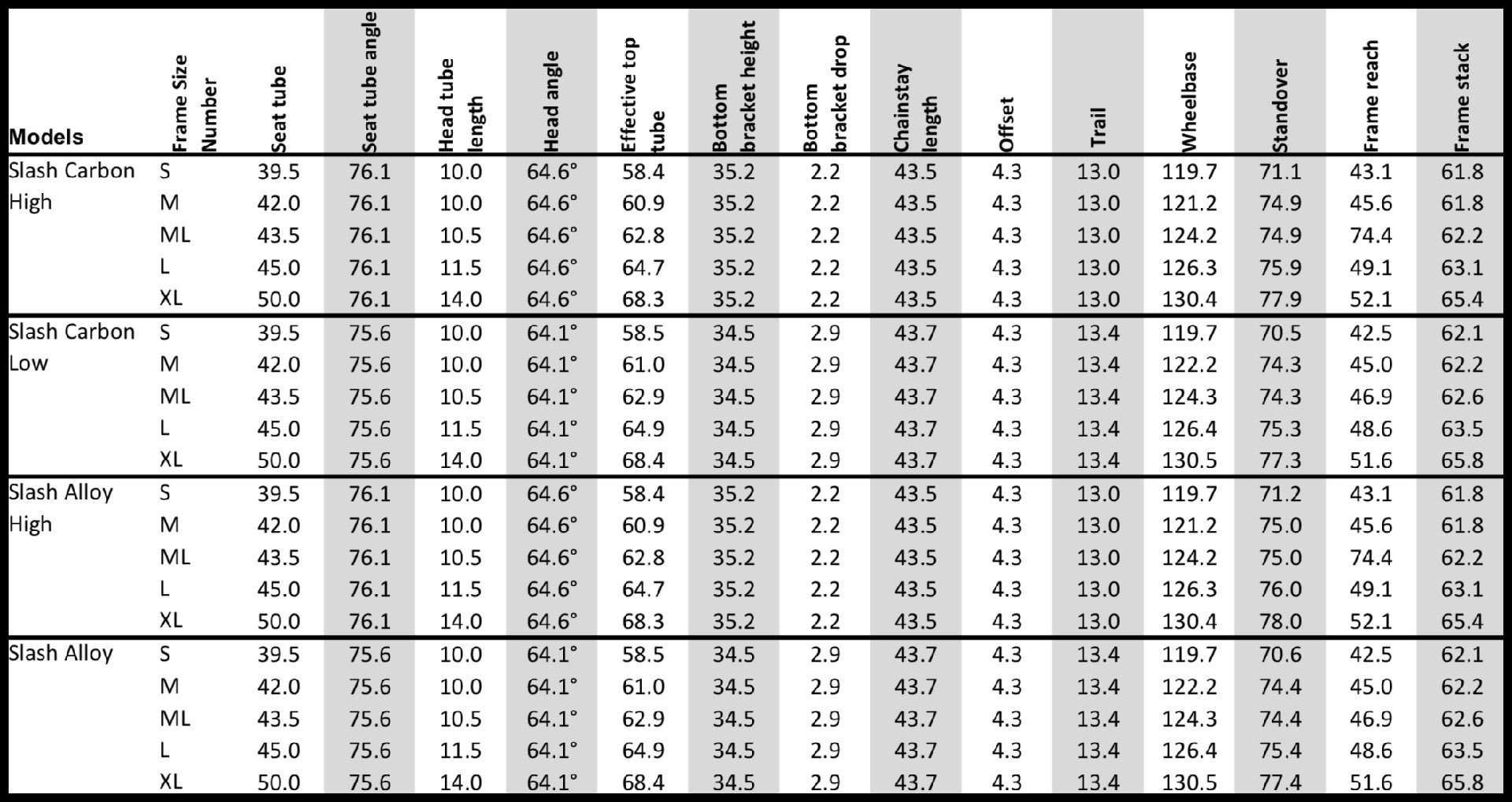
Geo numbers came from Trek.
Geometry
The shape of the Slash is very good with one exception: the seat tube. While the effective angle has shifted one degree steeper to 75.6º in low and 76.1º in high, the actual seat angle is a very slack 66.6 in the low position and 67.1 in the high orientation. If you happen to have short legs for your body shape this is not a problem, but it certainly is if you are long of leg, as I am. With the post at my preferred extension and the saddle centred on the rails it felt like I could barely reach the bars. To achieve a comfortable seated pedalling position, I had to push the saddle almost all the way forward on the rails. This is NBD with the saddle up but it means that when the saddle is down, it's too far forward for me to sit comfortably. I've become used to it in the time I've had the bike but this is certainly less than ideal for taller riders or those with proportionately long legs.
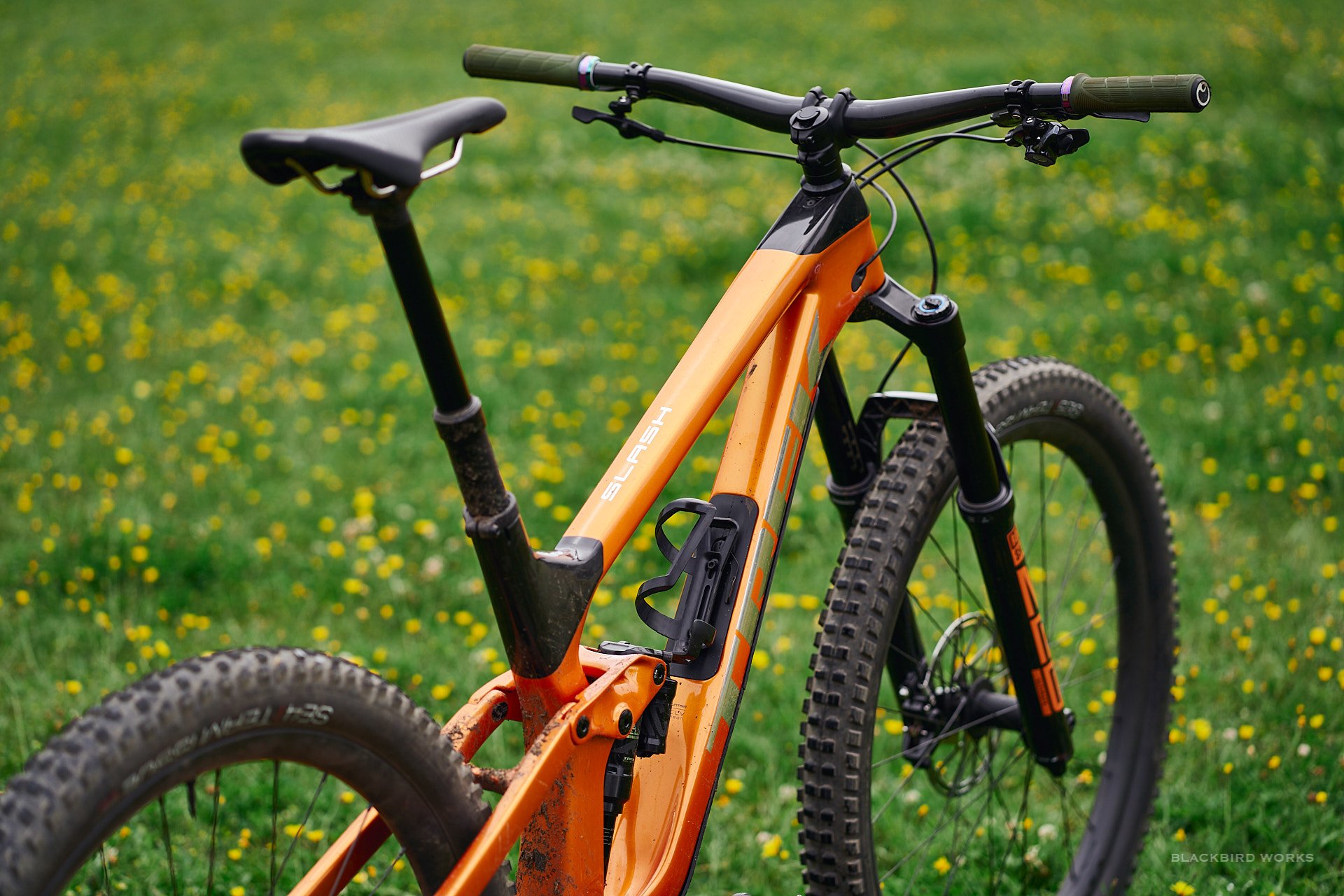
A whole lotta post coupled with the slack actual seat tube angle forced me to move my saddle forward almost an inch.
I rode the bike mostly in the low position but for my most recent ride, on less steep trails than usual on Mt. Fromme, it was in high and it felt a little more keen to pump and pop out of corners but not quite as stable at speed or pushing through rough bits.
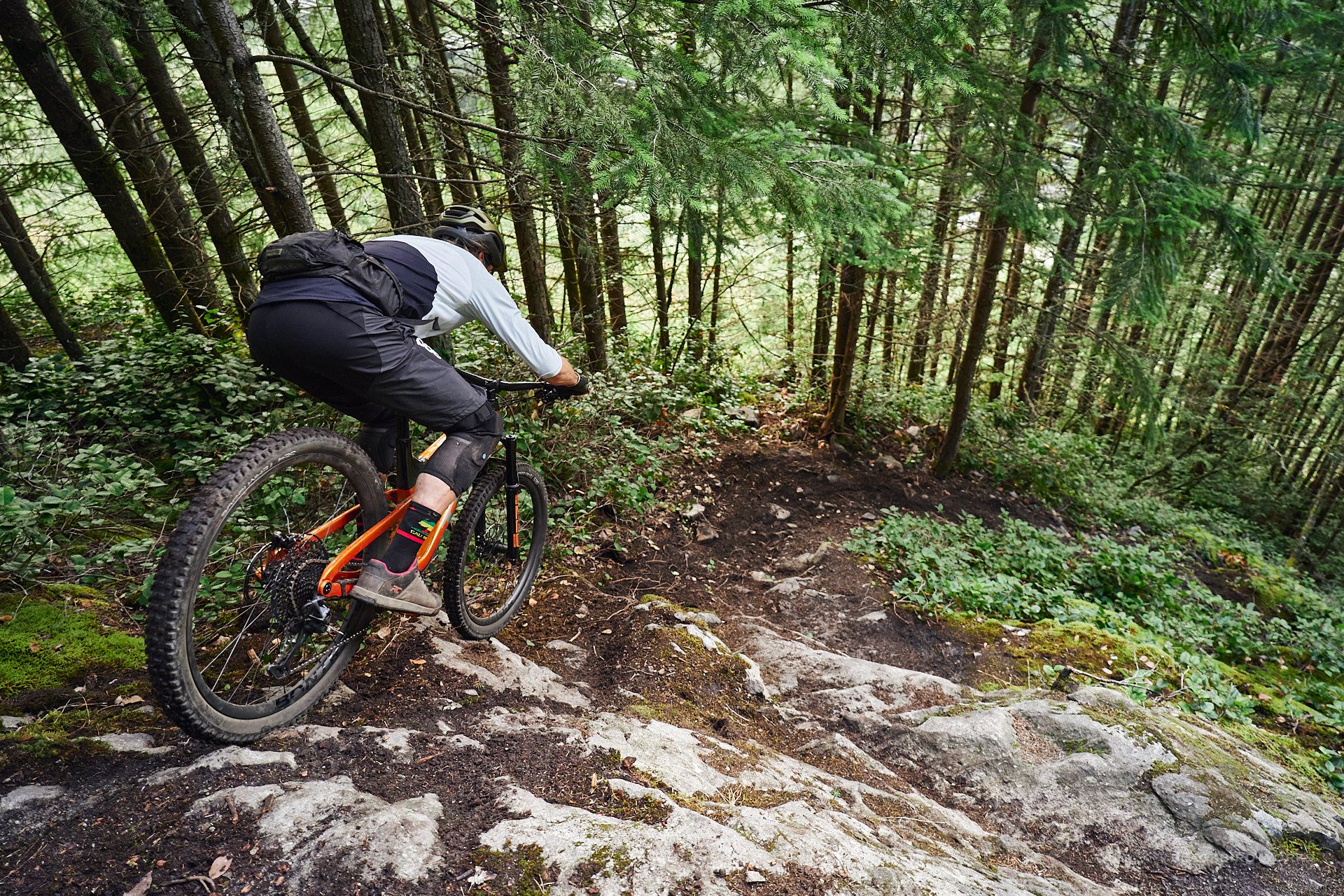
One part spec change I'd like to see is 200mm of extension for those of us who show lots of post. Now that I've grown accustomed to OneUp's 210 mm post a 170 feels too short and I found myself raising and lowering my post with the multi tool at the beginning of climbs and descents.
Parts Spec.
The model I've been riding is the Slash 9.9 X01, which you might think includes a complete SRAM X01 drivetrain. Unfortunately, like one of the Yeti's we tested recently, the only parts that are X01 are those with names prominently displayed; cranks, derailleur, and shifter. The cassette and chain are SRAM GX. While these are good quality parts, they aren't thought to be as durable as X01 and the cassette is a significant 150 grams heavier.
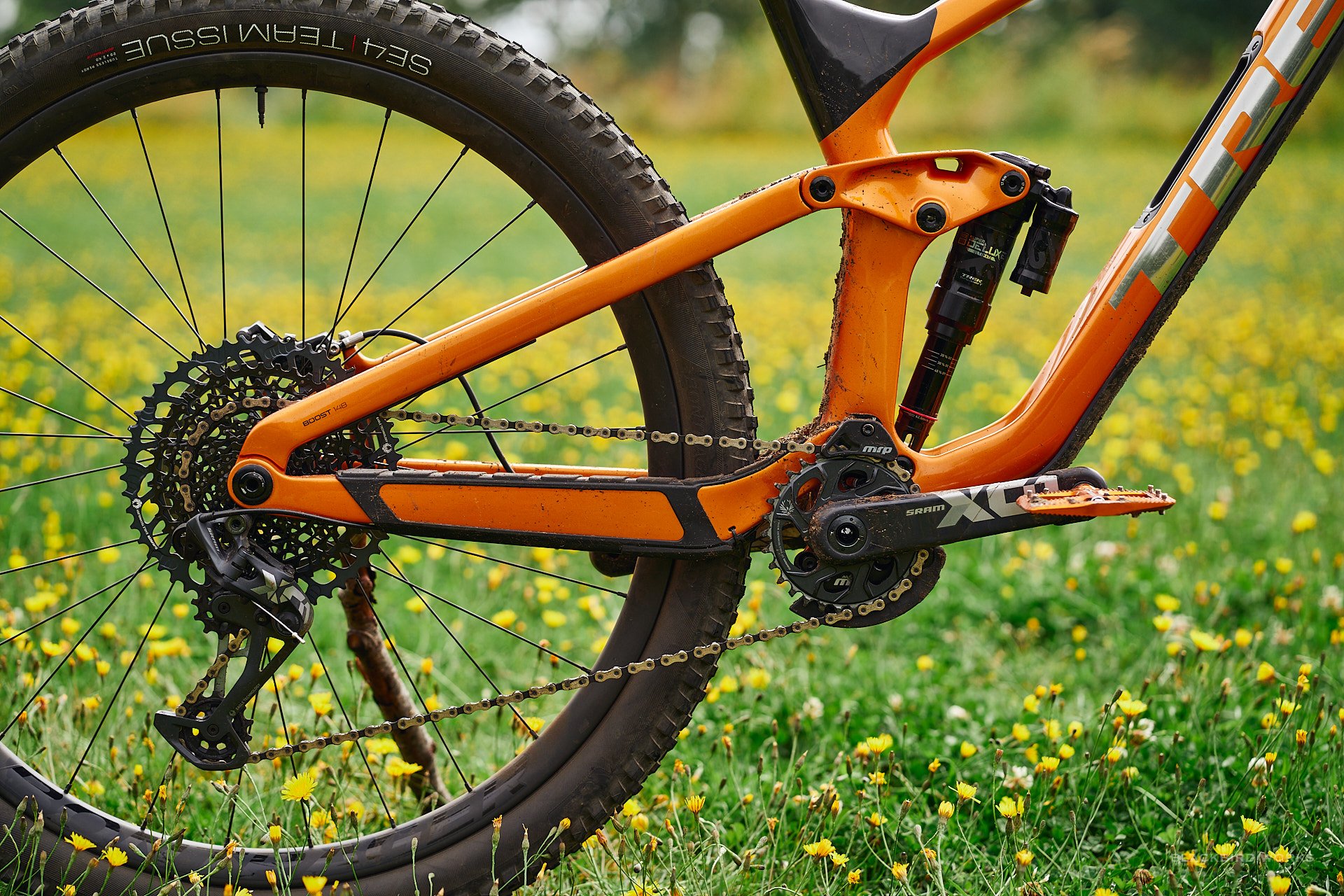
The drivetrain looks to be all X01, and the bike is called the X01 model, but the cassette and chain are GX, which doesn't seem right for a bike that costs 8,000 USD or 10,400 CAD.
That's my only gripe however, and the drivetrain performed flawlessly. It's also been awhile since I've been on SRAM Code brakes and the RSC models on the Slash are extremely good in every condition they've been exposed to.
After that, Bontrager parts take over. The Line Elite Dropper performed well but it is a little slow on the return. The new dropper lever is great however and I had no desire to swap it out. It's I-Spec EV and Matchmaker compatible as well. I've had no complaints about the Bontrager Line wheels thus far and the tires, (Bontrager SE5 29 x 2.60" front, SE4 29 x 2.40" rear, Team Issue, Tubeless Ready, Core Strength sidewalls, aramid bead, 60 tpi) have performed well in the relatively warm and dry summer conditions.
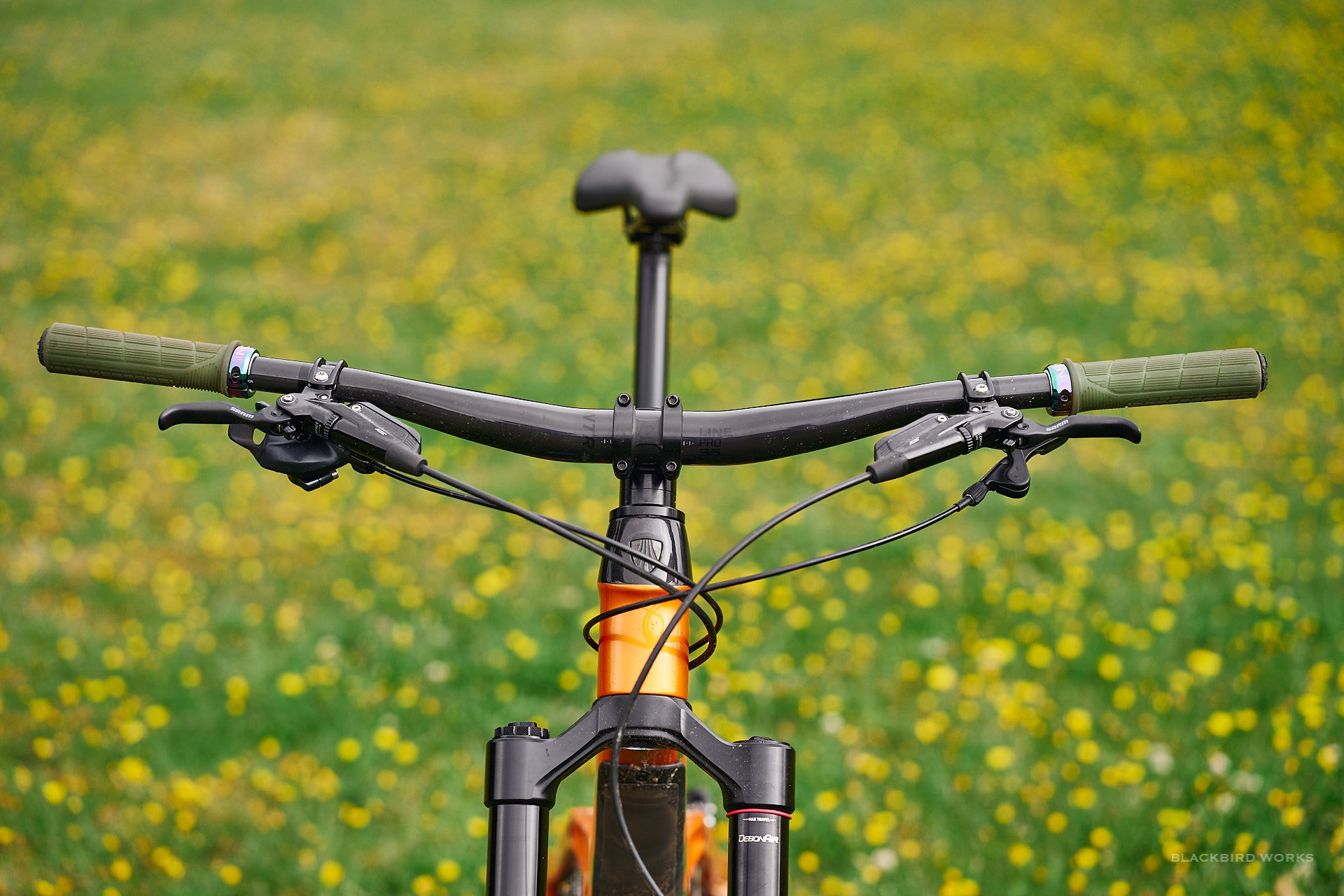
A tidy looking cockpit. Those are not the stock Bontrager grips but I neglected to swap them back for the photos.
The only Bontrager parts I had any issues with were the bars, saddle, and the grips. The grips are a personal preference thing of course, and I prefer something narrower and without an external collar but I could have ridden the included Bontragers in a pinch. The bars were initially 820mm wide, which is great for the gorillas out there, and you can of course always cut down a bar, and this one is now 770mm. The issue I have is that to make a handlebar that wide strong enough, it's likely going to have to be very stiff, and the bar is giving me sore hands for the first time in years. I don't find the saddle very comfy but it's quite soft so it may be that my bony butt is pushing right through the foam and resting on the shell. This isn't a deal breaker either and I haven't been bothered enough by the saddle to swap it out, but the bar is going to be changed shortly. All in all the spec is solid but, like most bikes in this era, rather uninspired.
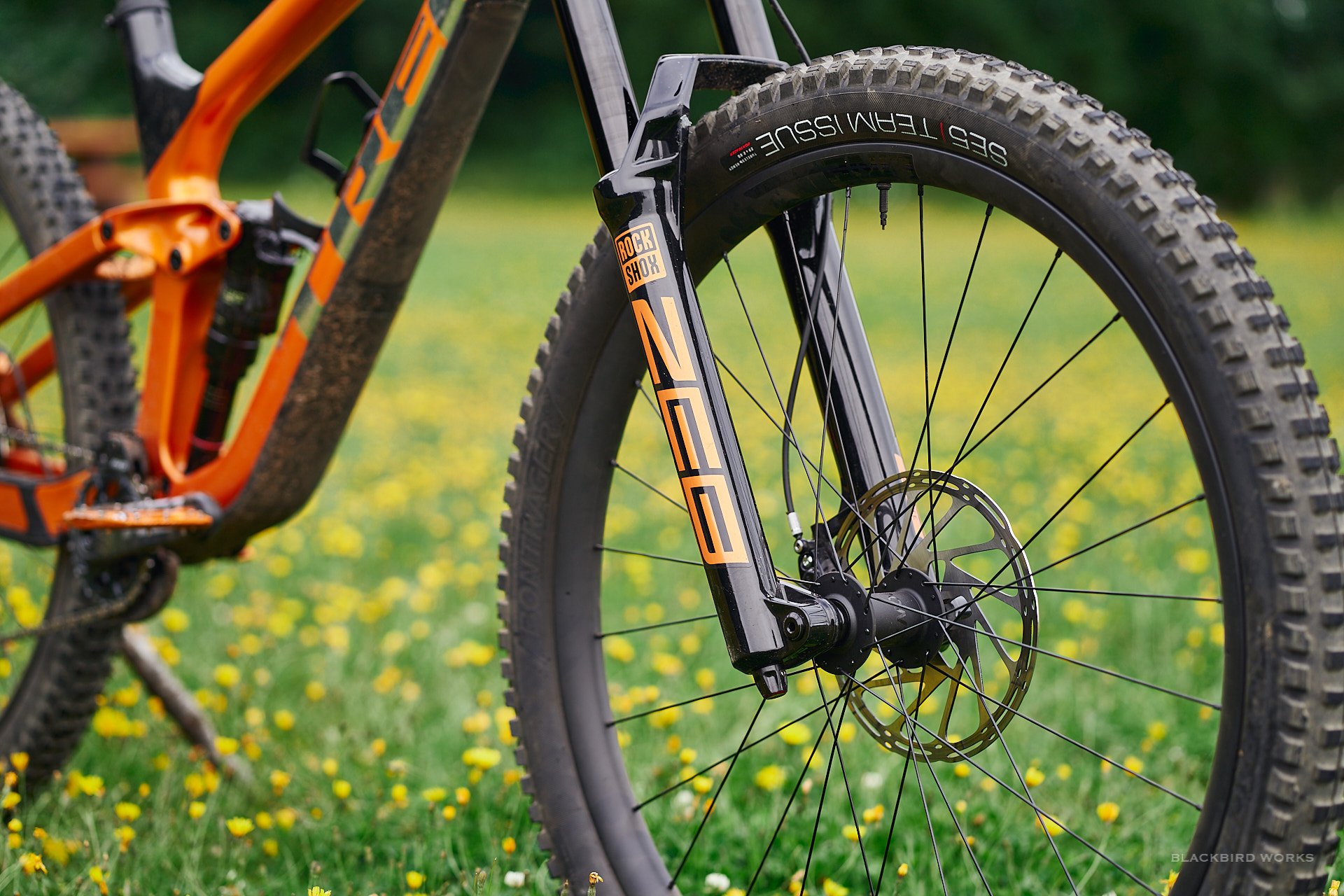
When I pulled the bike out of the box and saw the Zeb on the front I was a happy man. Photo - Cam McRae
Suspension
Up front I was happy to open the box and discover a 170mm RockShox Zeb Ultimate with a 44 mm offset. If you happened to read my review on this fork you'll know that I really like it, and this one was also excellent as soon as I pointed it down hill. The robust chassis pairs well with the very solid feeling Slash and it has kept me smiling at about 60 PSI.
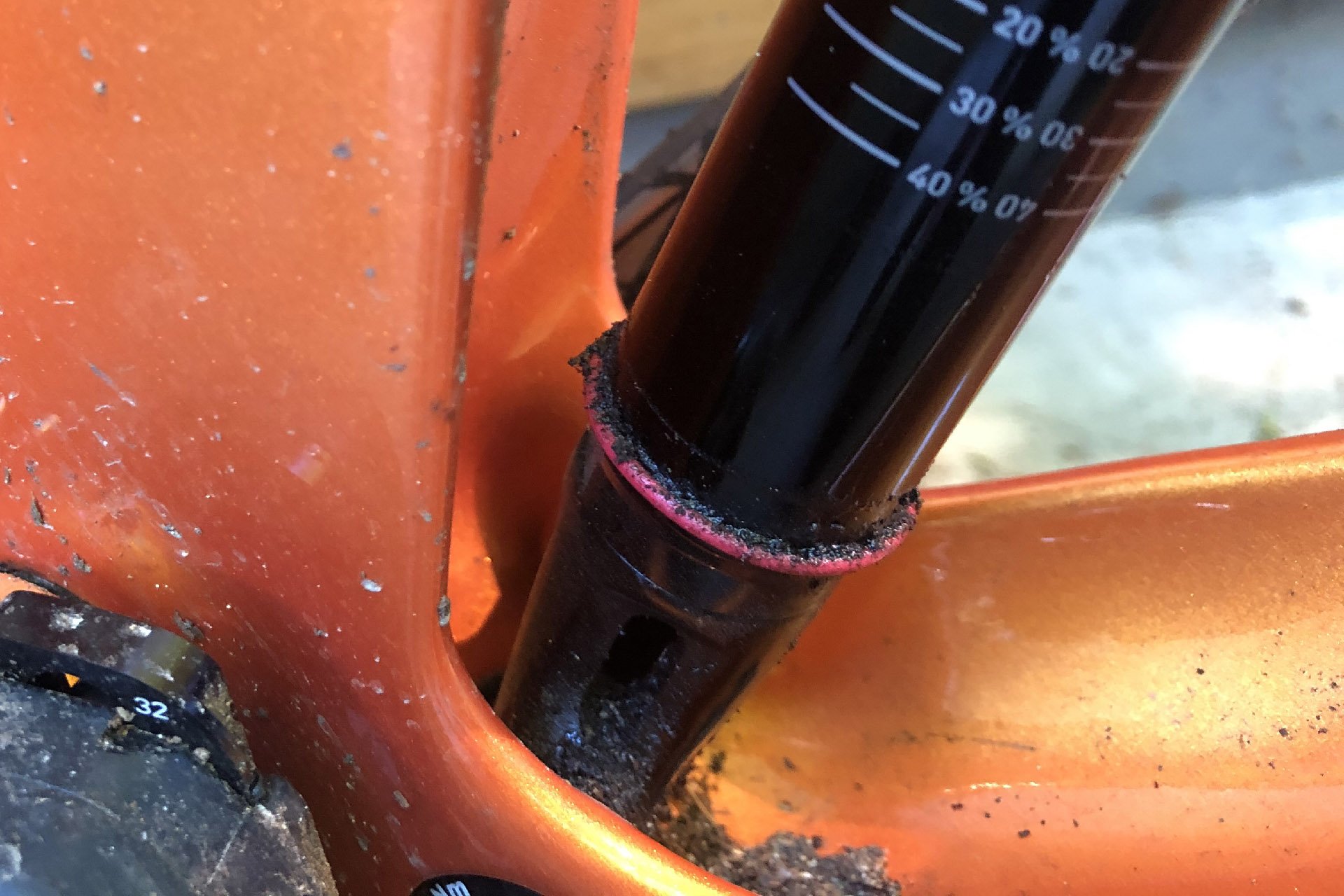
There is a small amount of oil present on the shaft of the shock. It's likely nothing to worry about but it's not something I'm used to. Photo - Cam McRae
The shock handling the 160mm of rear travel is a new unit that was the result of a collar between Rock Shox and Trek's suspension development department. By name it's a RockShox Super Deluxe Ultimate, DebonAir spring, Thru Shaft 3-position damper and it measures 230 x 62.5mm. Thru Shaft has been around for awhile and the claimed benefits are pretty significant. Because there is no internal floating piston or nitrogen charge, it runs at lower pressure and can be serviced by most shops. Thru Shaft shocks are also said to have a longer interval between services. The three position damper can be tuned easily on the trail to be neutral or have a slight increase or decrease in compression damping. As Chris Mandell of RockShox explained, you might put it to the plus position for A-Line and then twist it to minus for Schleyer in the Whistler Bike Park. So far the shock has been very good but I'm going to need more time on a wider variety of trails to dial it in and give a more thorough assessment. An unusual development is that it seems to be seeping a very small amount of oil. While this is likely nothing to worry about, it's not something I'm accustomed to seeing so it seems worth mentioning. We'll be digging deeper into the technology of this shock in the coming weeks.
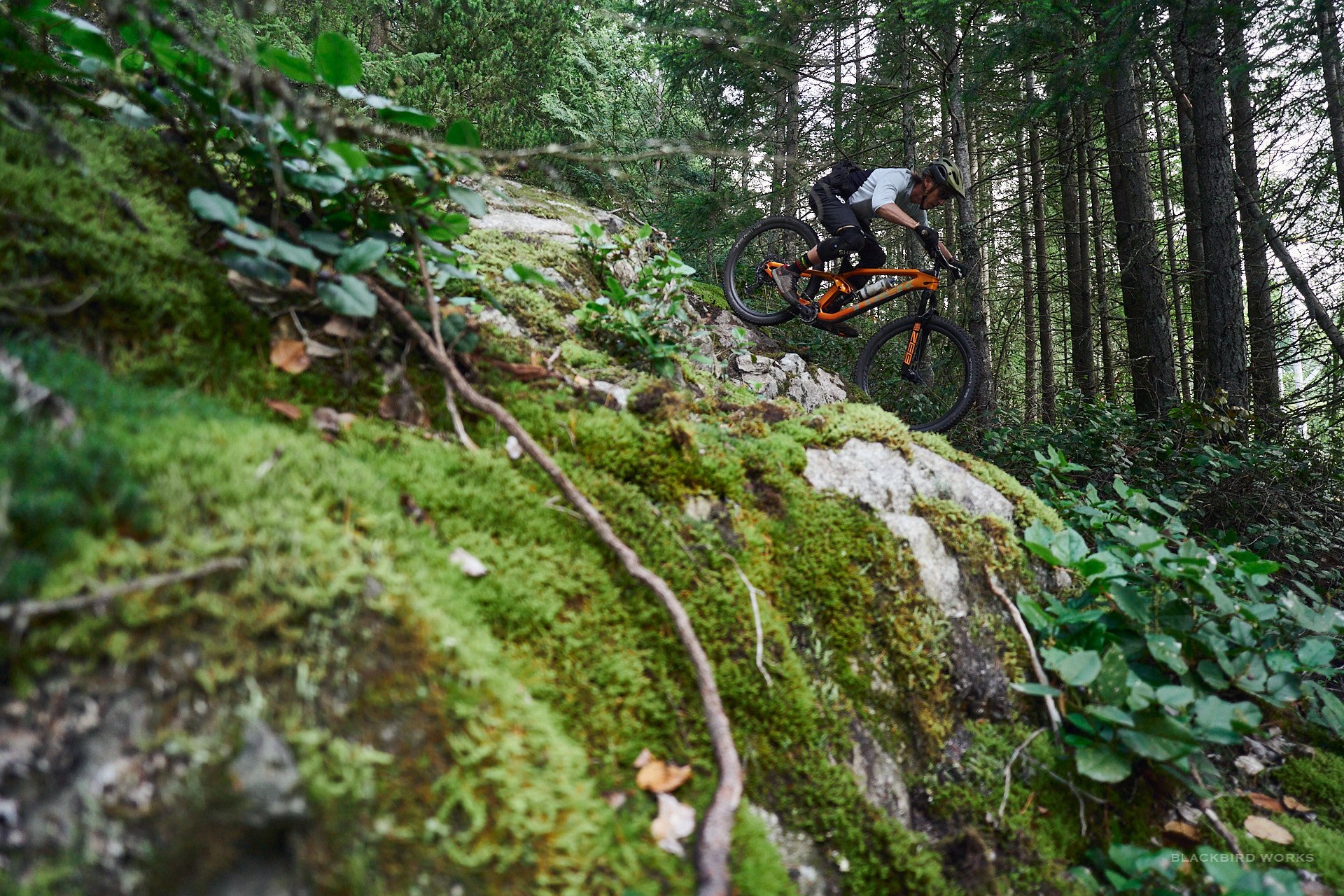
The Slash eating up some Cypress chunder on 5th Horseman.
Wheel and Tire Size
We had a little online session with Trek about the bike and they sent us along a FAQ page. One of the questions was about whether other wheel sizes could be used (no) and the other was max tire size (29 x 2.4). I took this as a challenge and rode the bike as a mullet recently with a 27.5 x 2.6 tire in the rear. It worked well and in the high position I didn't have significant pedal clearance issues, but the bike didn't seem to perform better overall and I missed the big rear wheel's willingness to skip over holes. I have also used a 29 x 2.6" tire in the rear and there is ample clearance. So much so that I wouldn't hesitate for a moment to recommend it, despite Trek's reluctance to do so. Be warned, however, that this could void your warranty.
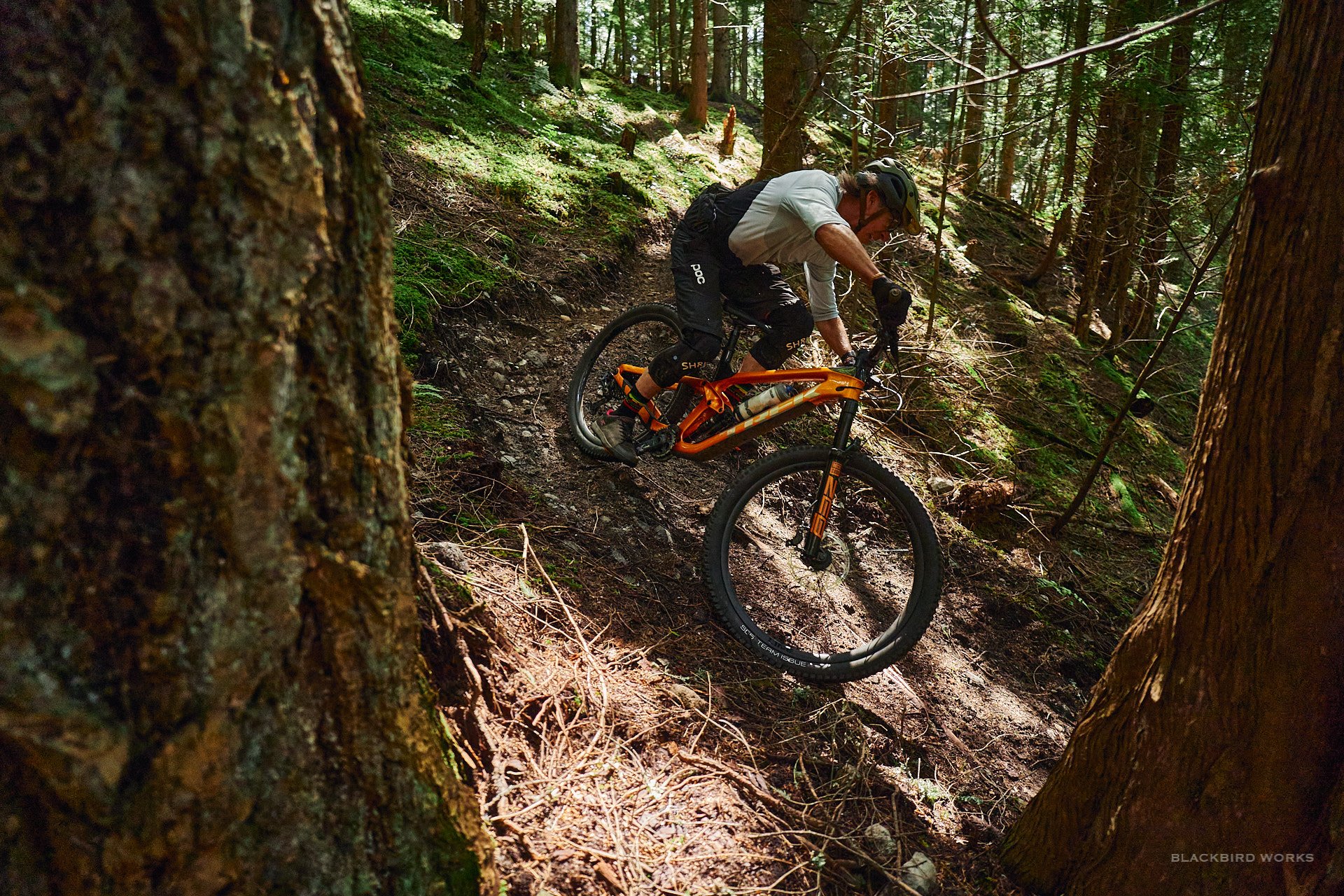
Steeps and corners, even when the come together, are easily handled by the 2021 Slash.
Handling
The 2021 Slash handles very well, both at speed and in slower tech sections. It's not as nimble as some bikes in the category, but it's adequate, and it compensates by being very solid and stable at speed. It holds a corner extremely well and the rear end is stiff and precise. It feels to me like the Slash takes a little more effort to tip into a corner or change direction, but once I learned the appropriate body english it became much more fun in the twisty bits. The bike chows down on rough sections and encourages me to charge a little harder, and it seems to feel better when I'm attacking and skipping over things. I don't yet feel like I've nailed the damping on the rear shock for a wide range of conditions and I think I'm running the fork a little too firm so this is only likely to get better.
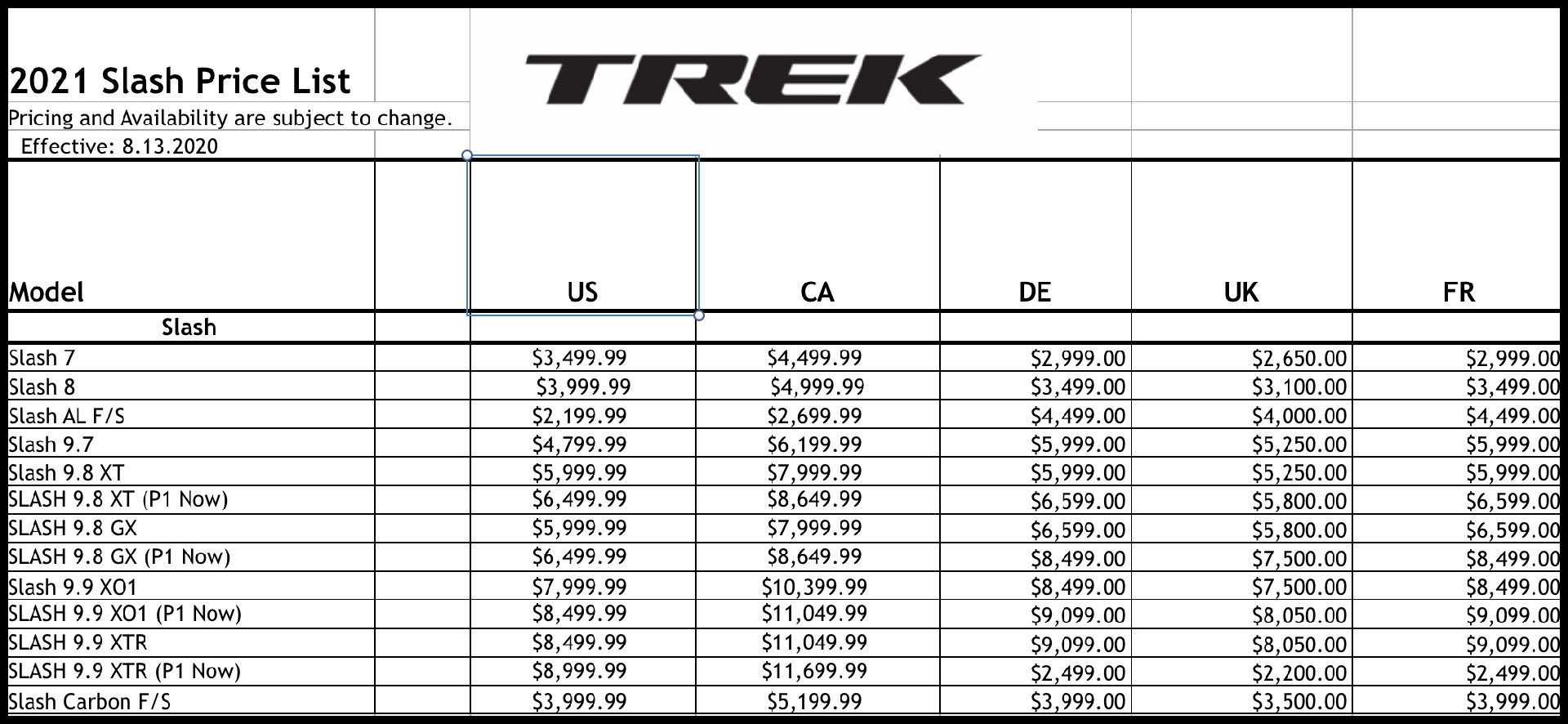
The Shimano XT version looks like decent value - for a bicycle that costs 8,000 CAD!
Overall
The first thing I noticed once I saddled up the Slash and pointed it downhill was a voice asking me if I was making the right trail choice. We were heading down a trail I normally wouldn't choose on a fresh bike, but I decided to give it a go on the Slash, and it was the right decision. This is an easy bike to ride and everything felt very natural from the first drop in and I haven't looked back since.
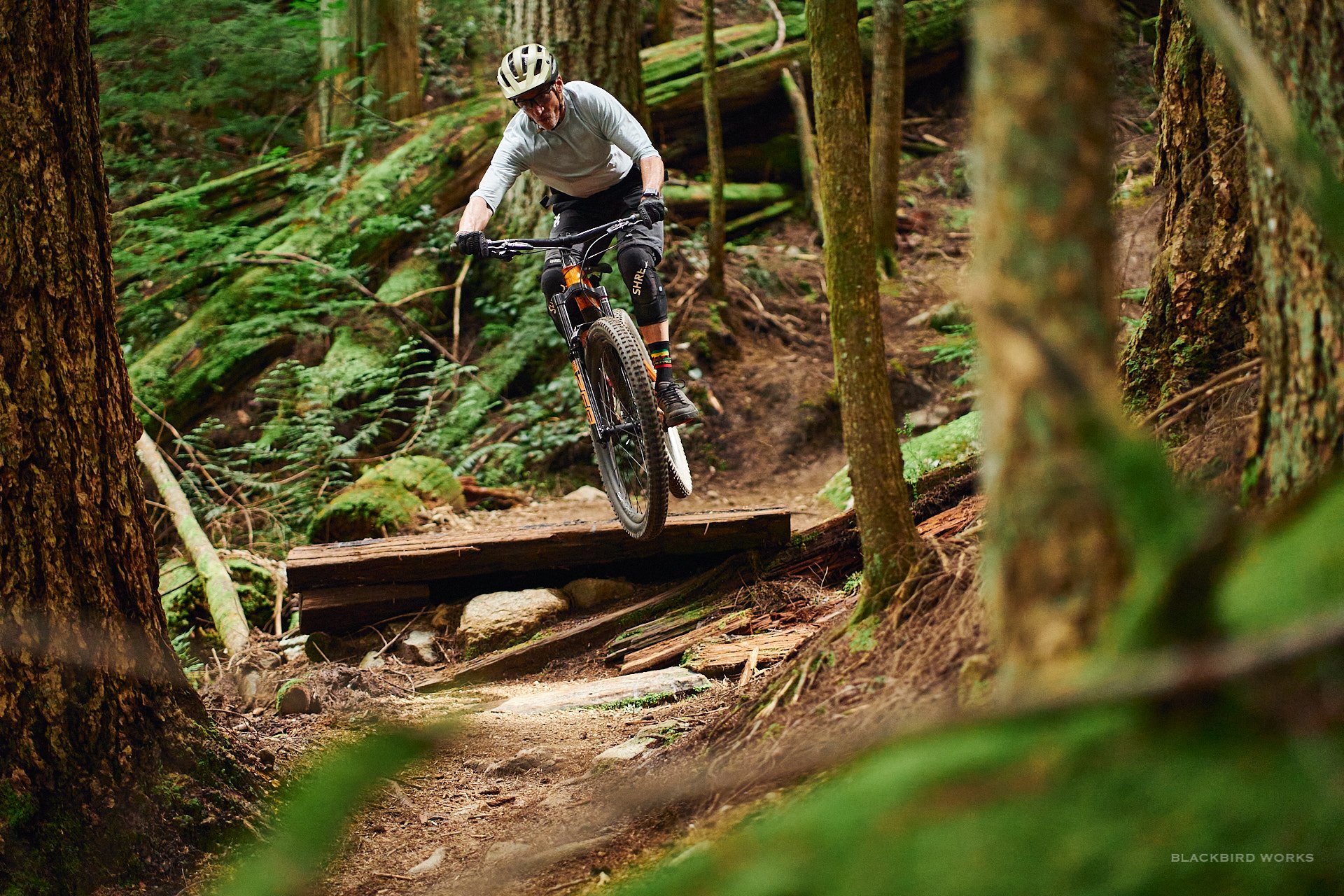
The Slash felt nice and stable in the air, even on wee gaps like this one.
This has been a weird summer for just about everyone and I haven't been riding in many of the places I try to hit up in the season, notably Squamish, Silver Star and Whistler. That means I'm going to need more time on the Slash before giving a final verdict, but the early returns have been excellent. One of the consistent impressions I've had is that this is a pleasingly solid feeling chassis that responds well to inputs. It requires a little more encouragement than some bikes I've ridden in this category, like the Yeti SB150 or Santa Cruz Bronson, but it responds more readily than the Santa Cruz Megatower.
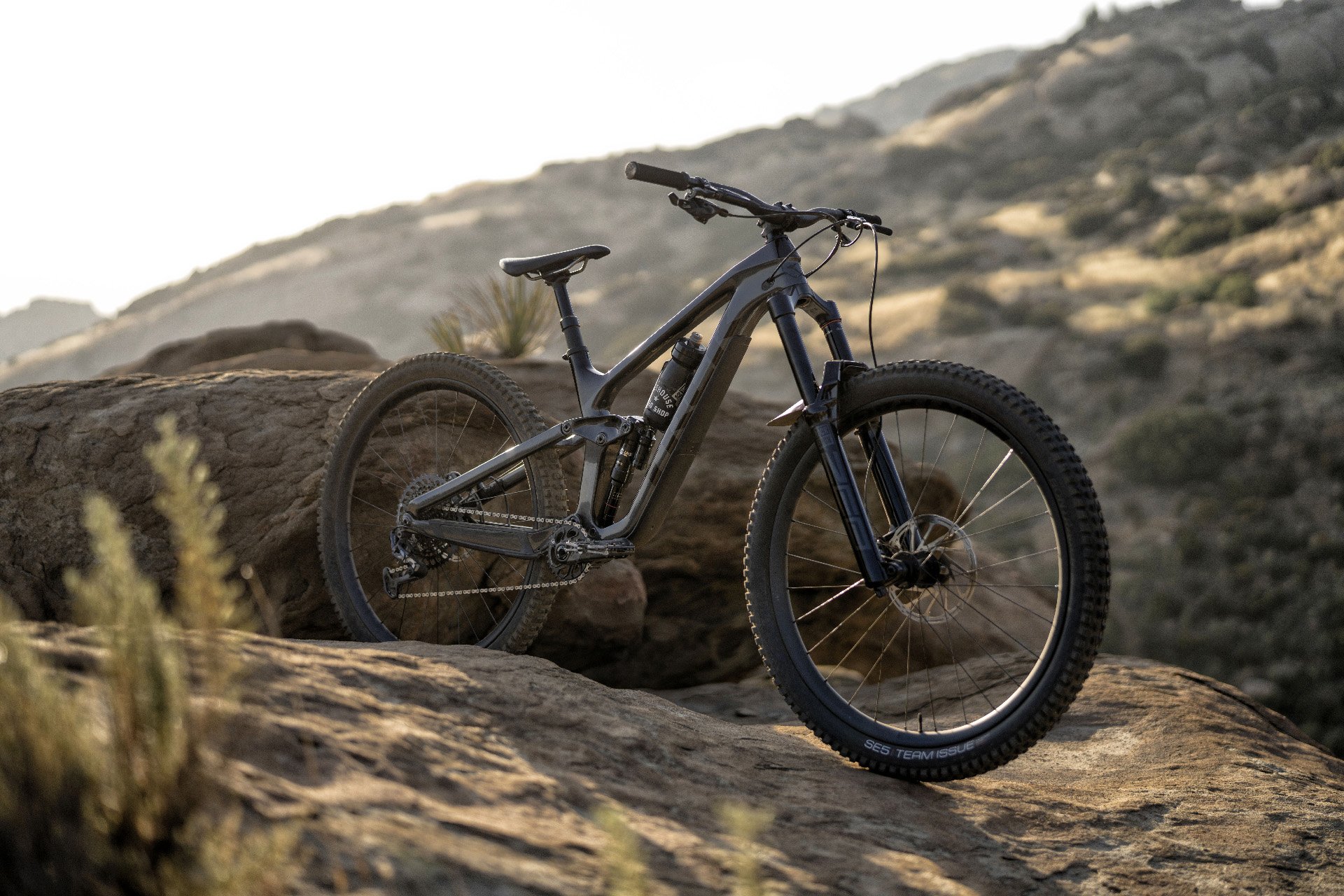
Of course there is a murdered out version. Photo - Trek
This new Trek Slash is great on rough, bermed corners and it has been an absolute monster riding steeps. I've climbed it up quite a lot of both singletrack and fire roads and (surprise!) I haven't felt the need to lock out the shock. It's very stable in response to pedalling inputs and I immediately felt how the stiffness of the bottom bracket area transferred energy efficiently, something I haven't notice on a long travel bike in a long time.
This is a hell of a bike and I seem to get a little more smitten every time I saddle up so it'll be interesting to see where that leaves me in a couple of months. For more info, head over to Trekbikes.com
Height - 6'/183cm (mostly legs)
Weight - 170lbs/77kg
Inseam - 33"/84cm
Ape Index - 0.986
Age - 58
Trail I've been stoked on lately - Sam's Dad's Trail
Bar Width - 760mm
Preferred Reach - 485-500mm (longer with 27.5 wheels than 29)
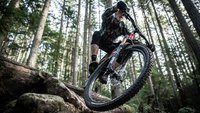
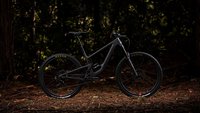
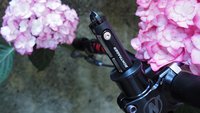
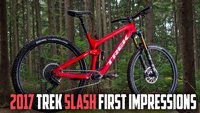
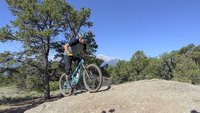
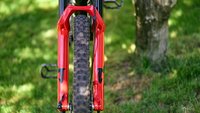

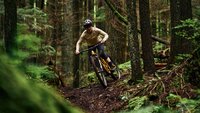
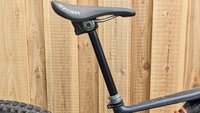


Comments
Timer
3 years, 9 months ago
I find this development really paradoxical: We made bikes out of carbon because it is lighter for a given strength. But they are fragile when exposed to impacts, so we make them heavier to cope with that. But that is still not enough, so we slap on enormous downtube protectors and cover them in frame wraps, adding even more weight.
Could we not have skipped all that and just kept the metal?
Otherwise a good looking bike which i might try if i was in the market. The finely grained frame sizes are a nice feature.
Reply
Dan
3 years, 9 months ago
Serious question: would you not run DT protection on an alloy bike?
Reply
Dave Tolnai
3 years, 9 months ago
CAD$11,000 MSRP (depending) and a GX cassette and chain? These are crazy times, indeed.
https://www.trekbikes.com/ca/en_CA/bikes/mountain-bikes/trail-mountain-bikes/slash/slash-9-9-xo1/p/33018/?colorCode=grey
Reply
Sean McDermott
3 years, 9 months ago
I agree, that's trash. Id rather have an X01 cassette and GX shifter and mech. For that price it should all be X01!
Reply
ackshunW
3 years, 9 months ago
Great honest review. Only because you mention it a couple times..... I understand there’s a Torx fitting cut into the other end (bottom by your fork crown) of the BITS tensioning screw. Presumably so you can adjust with the to itself!
Reply
WalrusRider
3 years, 9 months ago
It's really unfortunate the seat tube is so slack. At least for those of us with long legs. Also, for a bike at this price it should have X01 cassette and chain. Otherwise this looks like a sweet bike and I'd still like to demo one some time.
Reply
Dan
3 years, 9 months ago
At 6’5”, I’m a little anxious about the STA too. Eager for demo programs to come back full swing.
The inconsistent SRAM spec prompted me to review the details of the XT bike. Happy to see that’s truly XT through and through. That’d have to be my pick from these models: while $6K isn’t exactly pocket change, this build is a far better value than the $5500 USD MSRP 9.7 model from 2018 that I own. Why? NX 11sp gruppo, 125mm Bonti post, Yari fork, and butter-soft 28H Line 30 alloy wheels shod with XC grade SE4 tires. (I’ve since replaced each of those components).
Reply
AverageAdventurer
3 years, 9 months ago
The slash hit the scene in 2012 with 26 wheels and then switched to 27.5 in '14 and then made the jump to our now favorite wheel size in '16 Im pretty sure. Just a note on the last sentence of the first paragraph.
Honest thoughts all around! Great piece.
Reply
Cam McRae
3 years, 9 months ago
Thanks AA. I totally forgot about the earlier Slash models and have corrected my statement to read, "since the original 29" Slash was introduced, Trek hasn't produced one with smaller wheels." Cheers!
Reply
Velocipedestrian
3 years, 9 months ago
Is there a drain for the swimming pool around the lower shock mount?
Reply
Nouseforaname
3 years, 9 months ago
Apparently, yes.
Reply
Luix
3 years, 9 months ago
I've always felt the Mino Link was more of a marketing gimmick than a real improvement. Half a degree if change in the geometry? I can achieve that playing with the tire pressure or the shock's SAG.
When I had a chance to swing a leg over the previous version a friend bought a few months ago, it didn't provide a significant change in the bike's handling. More of a mind game than a true geometry change if you ask me. Or maybe you need to an EWS level rider to acknowledge such subtle alterations.
Reply
Kos
3 years, 9 months ago
No EWS rider here, but I certainly could pass the blindfold test when swapping mino link positions on the previous version.
I prefer the handling in high, but the cornering in low. Solved with a 150 mm air shaft in the fork, to pull the bb down a bit, and steepen the HTA a bit, when in low.
Note that my use is very rugged trail riding. No bike park-style stuff, so big caveat, for sure.
Reply
Dan
3 years, 9 months ago
Good call out. I set my '18 in low from the outset but later upped my Yari from 160- to 170mm (plus Charger 2 and Debonair spring). You comment gets my thinking I'll set it to high and see if there are any noticeable differences.
Reply
Kos
3 years, 9 months ago
I don't like overly-low bb heights, but found the previous Slash a bit too high in the high position. It made the bike feel a bit teeter-tottery when cornering on flow trails. But you could pedal through anything.
Have fun experimenting!
Reply
WalrusRider
3 years, 9 months ago
After looking through the spec of these bikes, the XT 9.8 or 8 if you want aluminum seem to be the best bang for the buck. It's awesome Trek was able to fit frame storage in the aluminum frames in addition to the carbon. At least on paper, this bike is looking like it may be the right one for me despite the seat tube angle. That frame storage is a big selling point and I felt like the Specialized Enduro is too long and too plush. Maybe the Slash will be just right? I'm looking forward to the long term review.
Reply
Endur-Bro
3 years, 9 months ago
I demo’ed the first 29er Slash 9.9 at Crankworx a few years ago. I took it for a Garbo to village proper shakedown. I was in the 29ers are awesome camp then and that proved my theory.
The fool that I am only rode the M size and not the L size as well. which ended up being good as I ordered a G16 instead of a Slash. I wanted a longer FC and steeper STA. Retail frame pricing was about the same.
I feel slack STA, small reach, short CS are a byproduct of bike bicycle. This bike not only needs to sell in PNW, Euro Alps, Killa Cali and Enduro heads worldwide but also Mid-West USA and Prairie Provinces where almost all should be on a Fuel EX.
Reply
Buzom
3 years, 9 months ago
Anyone know what is up with the oil on the rear shock? My wife's Norco sight has the same thing going on since May and I have been spelling it off as odd but normal. But it seems to be getting worse so now I'm not so sure?
Reply
Dan
3 years, 9 months ago
My '18 Slash has slowly wept oil like that since I first bought it. What makes it look 'bad' IMO is that the oil collects dirt so the volume looks greater than it is. I get the shock serviced every season and it keeps on (monster) truckin'.
Reply
gtdefran
3 years, 9 months ago
Hello Cam,
What pedals are you running on the Slash?
Thanks
Reply
Cam McRae
3 years, 9 months ago
Canfield Crampons. I like them a lot so far with mostly long pins. The colour match was a fluke though.
Reply
Tim (aka DigitBikes/DirtBaggies)
3 years, 9 months ago
Is there a hex socket in the bottom of the headset tensioner device to allow you to tighten the headset from the underside of the fork steerer, using the multi-tool?
Reply
Cam McRae
3 years, 9 months ago
Confirmed! Thanks again for the heads up.
Reply
Tim (aka DigitBikes/DirtBaggies)
3 years, 9 months ago
This comment has been removed.
Sean Chee
3 years, 9 months ago
Interesting note about the kb screw. I use a heap of m3 screws everyday on equipment that carries heavy loads with sub arc second accuracy. I've never stripped one of their heads.
Do you think the kb screw is alloy, or perhaps it's using that heat only removal loctite?
Reply
Cam McRae
3 years, 9 months ago
I’m not sure if the hold of the fitting is the issue. As I said, it felt soft right away so perhaps it was damaged during assembly or maybe it is faulty. I may be able to tell when I eventually get it apart but that remains to be seen.
Reply
Please log in to leave a comment.